Hunter × Hunter × Little × Things
The little things that make H×H great
The media attached to this page belongs to their respective owners, who are most likely Yoshihiro Togashi, Shueisha, Nippon Animation and Madhouse. Also, thanks to Hunterpedia1 wiki for resolving my general doubts.
Introduction
Hunter × Hunter or shortly H×H, is easily my favourite anime ever. The list of things I love about it is infinite, from its childish beginnings to its subversive endings to its story arcs; from its consistent animation to its perfect music; from its interesting characters to its expressive power system, and beyond.
The purpose of this post, however, is to elaborate upon an underrated aspect of storytelling mentioned in my HxH thoughts. And that is the recurring attention to detail put in by its author, Togashi-sensei.
Ideas are built up from seemingly mundane moments but are then reused at important moments on a much larger scale. This approach of consistent world-building avoids an over-reliance on shock factors, making the story feel more natural. It also rewards attentive viewers with not only a better understanding of the ongoing moments but also the satisfaction of grasping better context of previous moments. While this anime is filled with information, there are still secondary details that it expects the audience to fill up by connecting the dots.
It also helps that such ideas are not lost and in fact, many such ideas are consistently utilised to make developments. Such consistent use of ideas is what I will highlight in this post.
Thanks to Muse Asia, this anime is legally available on YouTube free of cost for most Asian countries. Also, they have made the first six arcs as standalone videos to cater binge watchers. Check out their stuff if you plan to
rewatch the show. For western audience, Crunchyroll provides the first 25 episodes of the series for free.
Before delving into specifics, let’s start with my favourite example which actually comes from one of the lowest rated episodes of H×H on IMDb.
From now onwards, this post will dive into spoiler territory. So, come back after watching 148 episodes of this anime. Just kidding :p, feel free to do what you want.
 Episode 48
Episode 48
Gon and Killua stumble upon this “worthless” wooden statue in search of rare items to earn money. Zepile an appraiser, helps them to avoid getting scammed and teaches them about a counterfeiting technique called ostomy, which is creating an opening from an area inside the body to the outside. Now, when the duo was stuck in a guarded room, look what the boys did :) 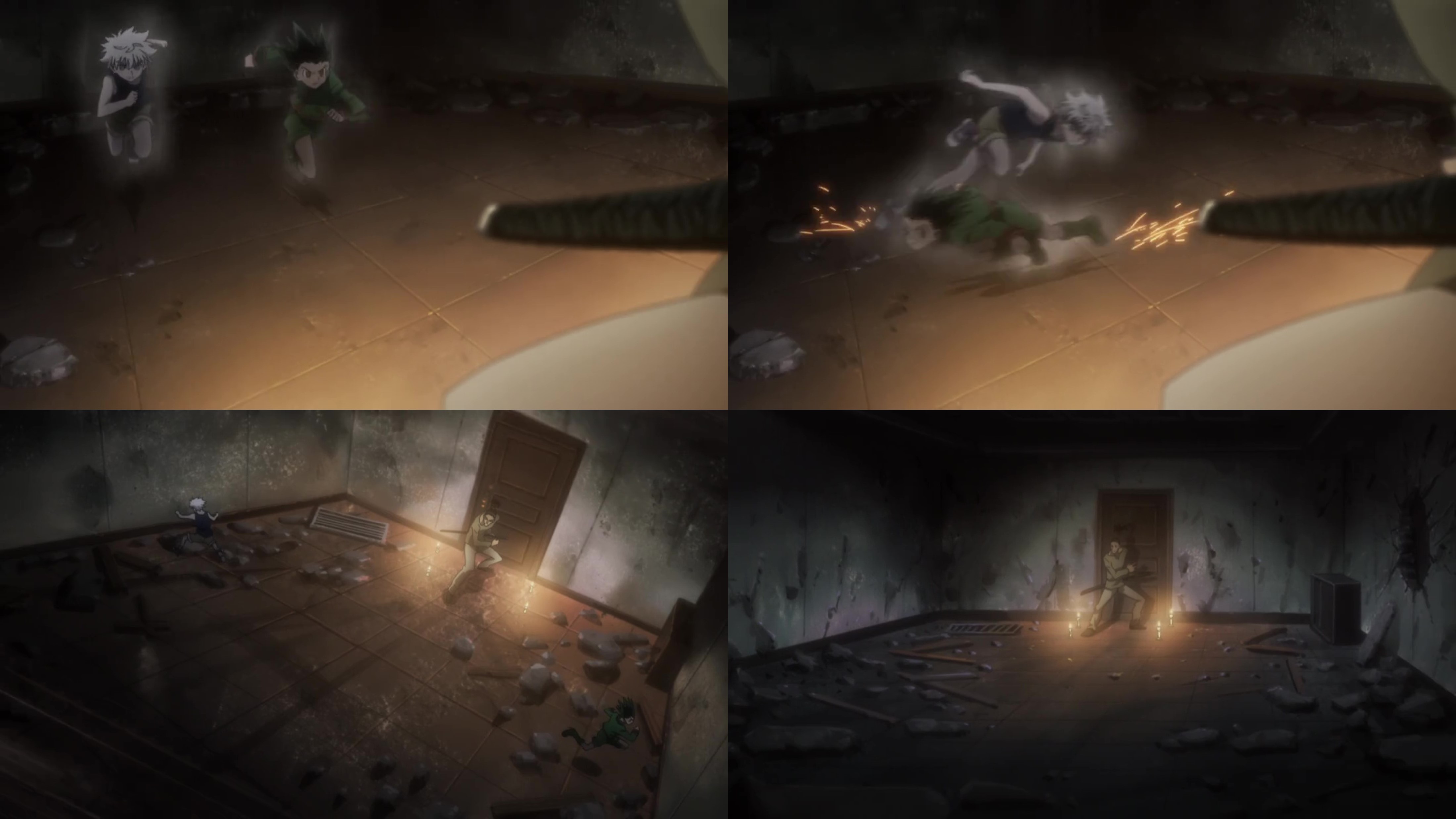 Episode 50 But not only that, a similar situation had occurred earlier during the Hunter exam where Gon noticed that the wall could be broken and then proceeded to make his own entrance.
Episode 50 But not only that, a similar situation had occurred earlier during the Hunter exam where Gon noticed that the wall could be broken and then proceeded to make his own entrance. 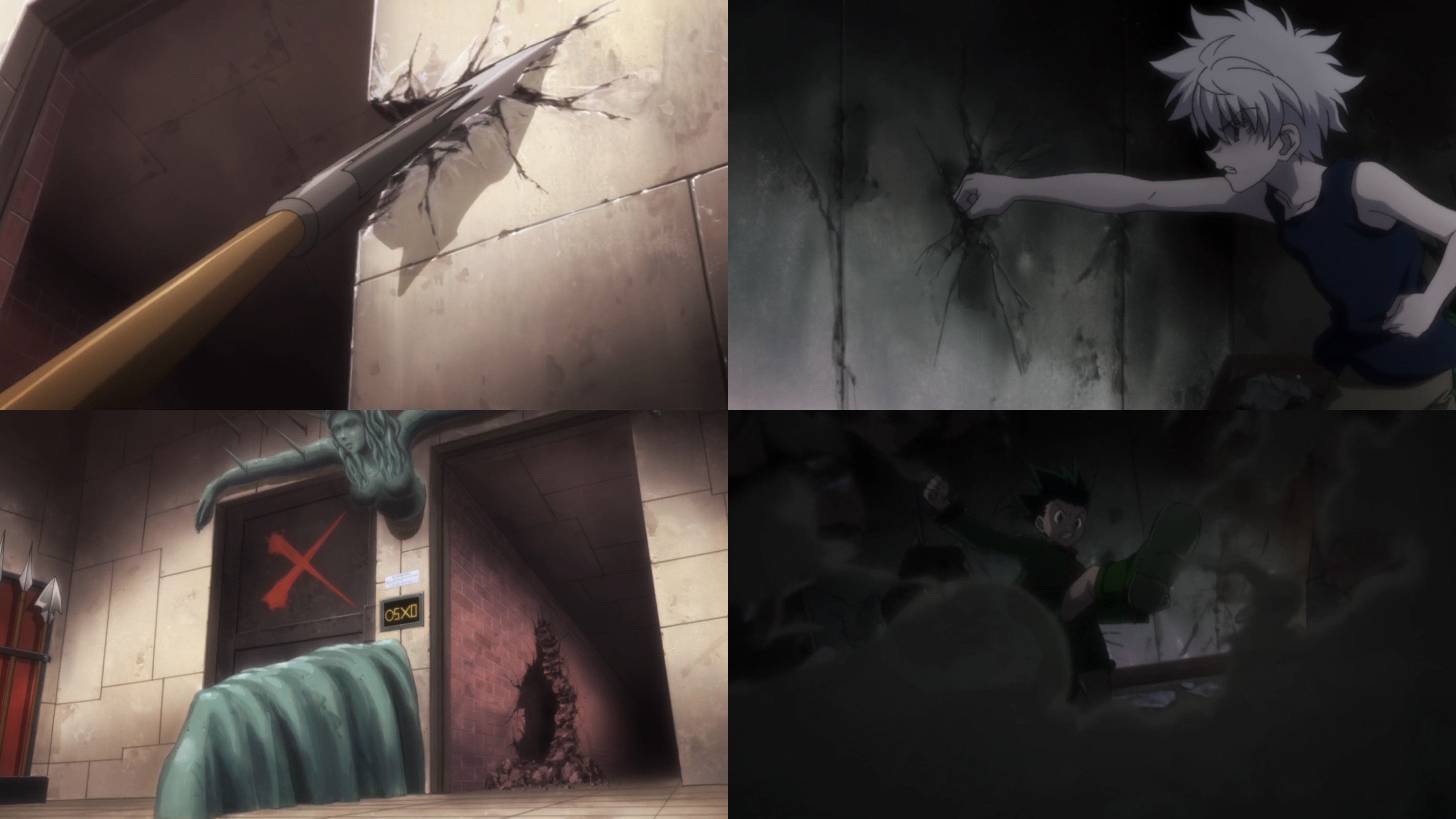 Episodes 12, 50 And there’s more, this episode 48 also establishes a key point regarding Nen, which will be explained in a coming section.
Episodes 12, 50 And there’s more, this episode 48 also establishes a key point regarding Nen, which will be explained in a coming section.
Hereafter, unless otherwise stated, the relevant images are placed above the text that references it.
Visuals
Silhouettes
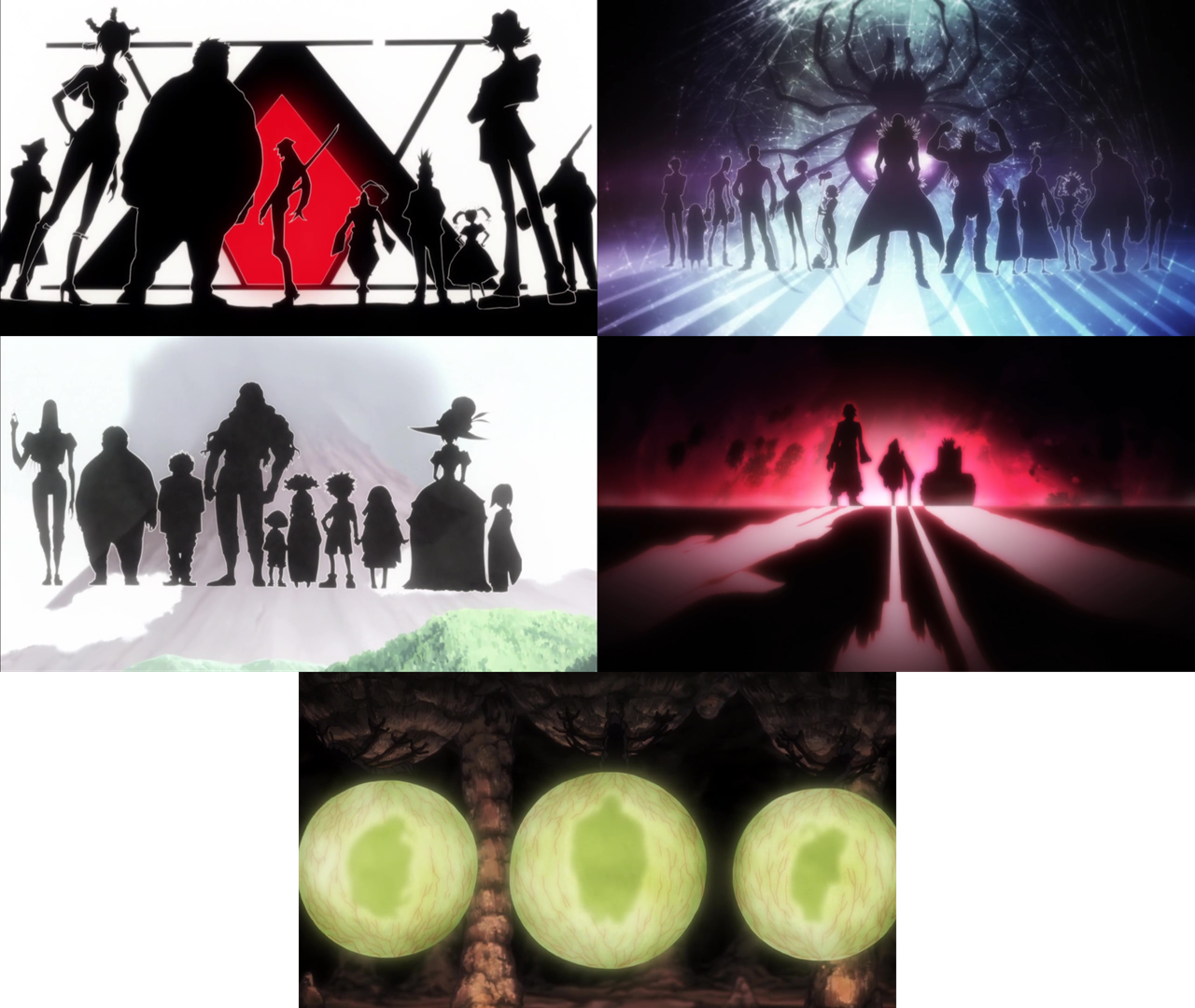 Episodes 1, 9, 23, 29, 84 A common theme before introducing a cast of characters is to share their silhouettes. From the shot of Hunters, the Zoldycks and the Heavens Arena contestants to the shot of the Troupe, and the Royal Guards.
Episodes 1, 9, 23, 29, 84 A common theme before introducing a cast of characters is to share their silhouettes. From the shot of Hunters, the Zoldycks and the Heavens Arena contestants to the shot of the Troupe, and the Royal Guards.
Not only does this introduces us to these characters way before they actually appear (such as Kite, Morel or Knuckle) but they also give subtle cues for the attentive observer such as
- Hisoka at the right end of Troupe’s picture adds more context to his presence in the Hunter exam and his final fight with Kurapika.
- Killua holding hands with someone signifies a close relationship with the later introduced Alluka.
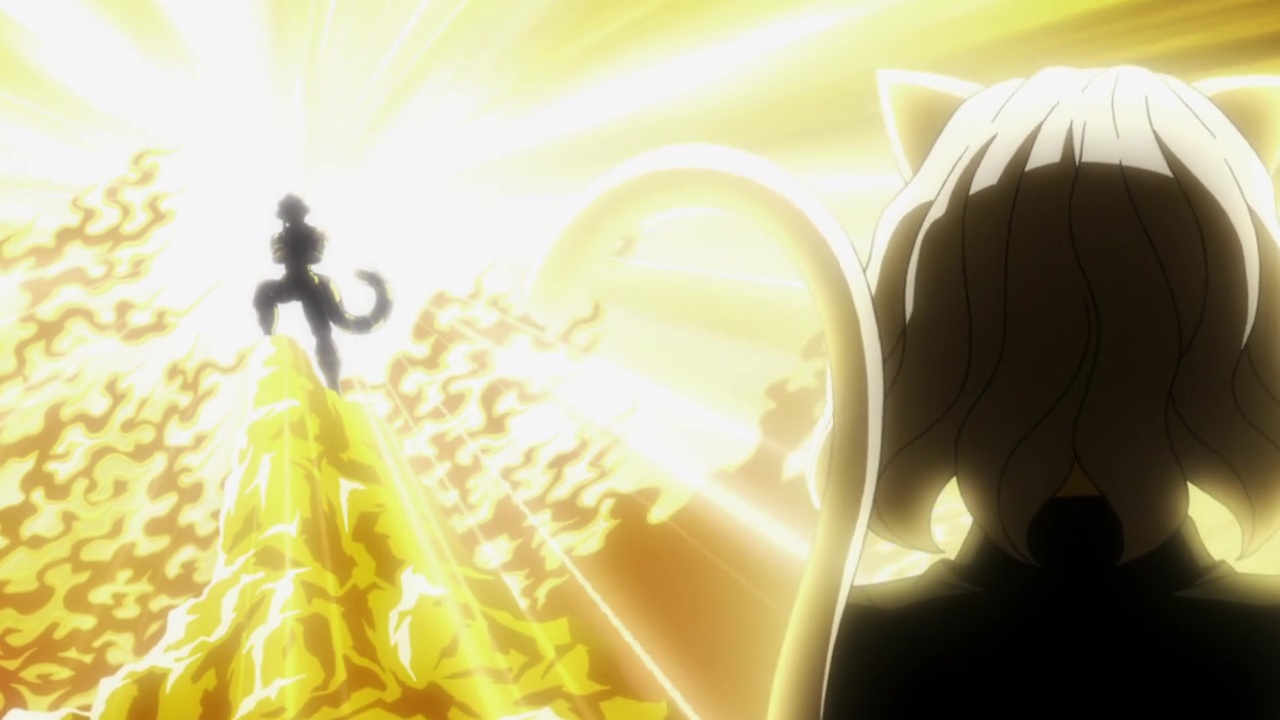 Episode 84 A silhouette of the King displaying his immense power before he is even born.
Episode 84 A silhouette of the King displaying his immense power before he is even born.
Smoke
 Episode 43, 84 Both Uvogin and Kite appear out of the smoke totally unharmed, which crushes the enemy’s will.
Episode 43, 84 Both Uvogin and Kite appear out of the smoke totally unharmed, which crushes the enemy’s will.
Mysterious × People
 Episodes 21, 43 The shots of Ging’s flashback and Ten Dons are both visually striking.
Episodes 21, 43 The shots of Ging’s flashback and Ten Dons are both visually striking.
Shadows
 Episodes 2, 34 We see similar imagery when our trio and Hisoka leave the location and proceed to the next stage.
Episodes 2, 34 We see similar imagery when our trio and Hisoka leave the location and proceed to the next stage.
Camera × Roll
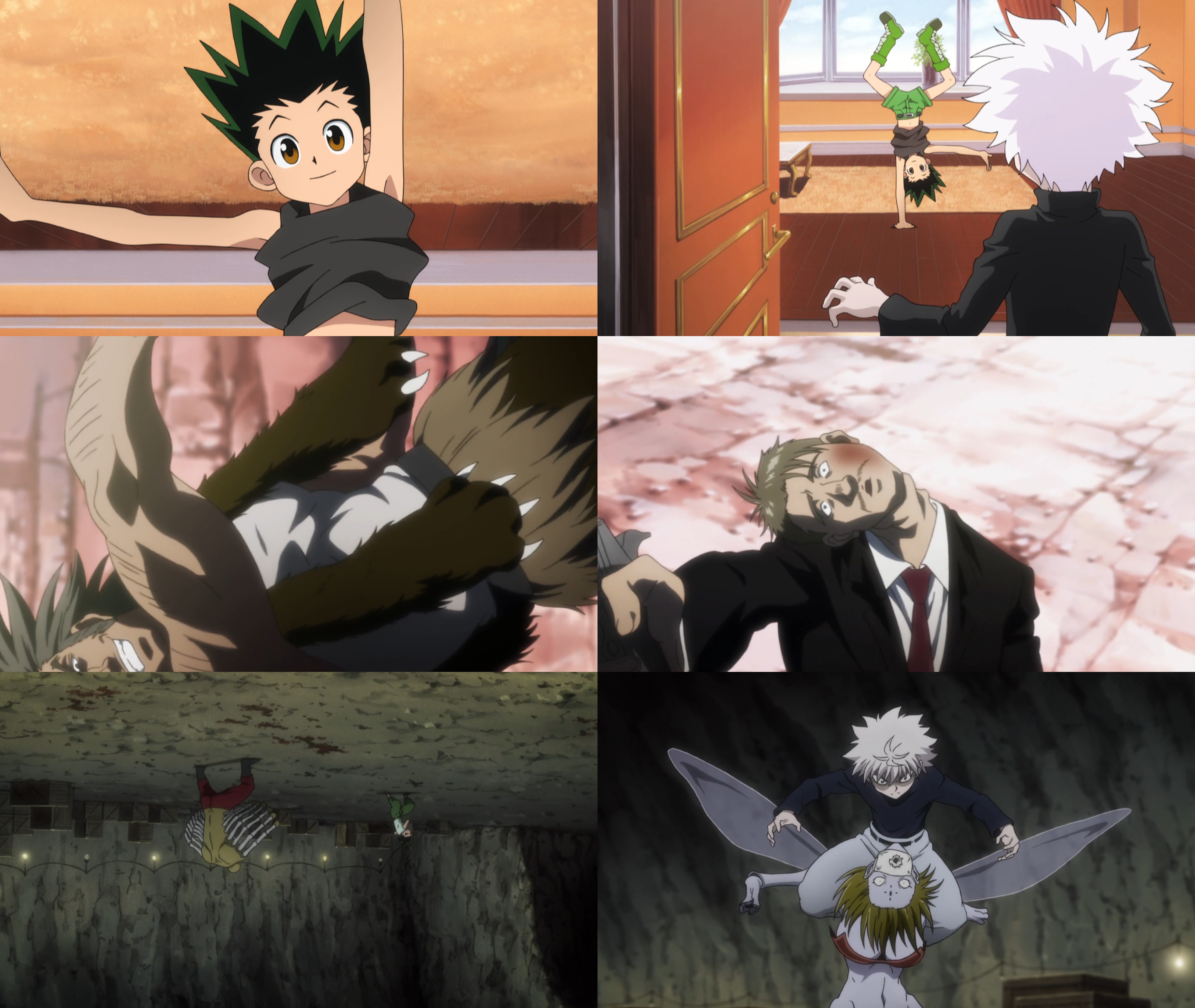 Episodes 31, 43, 82 Whether it is Gon’s usual exercise or Uvogin’s massacre or Killua’s brutal kill, we see the camera roll with an uncomfortable view.
Episodes 31, 43, 82 Whether it is Gon’s usual exercise or Uvogin’s massacre or Killua’s brutal kill, we see the camera roll with an uncomfortable view.
Omnipresent × Nen
Nen is the De facto power system of H×H. And arguably the best an anime has offered yet. Though it is officially introduced to the protagonists in episode 28, Nen was always present in the series, even before this introduction. Of course this makes sense, after all Nen wasn’t invented for the protagonists.
I won’t be delving into explaining the specifics of Nen, nor is it required for this blog, but if you are interested, refer to the wiki.
So, here are some instances of early Nen.
Intentional × Usage
Cases with intentional usage of Nen by people
Hisoka
♦ Hisoka ♣ Morow ♥ the ♠ magician ★ 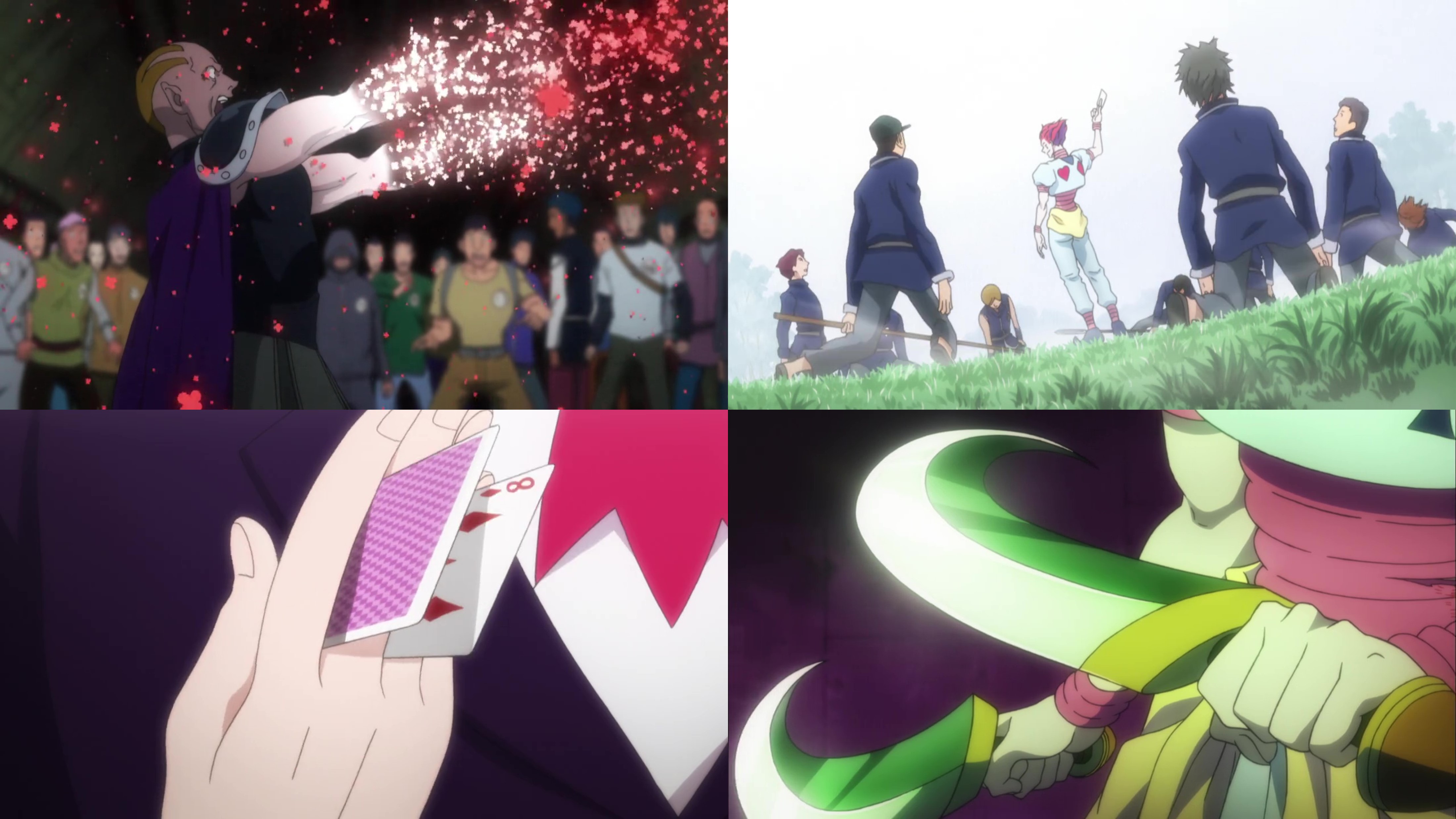 Episodes 3, 4, 5, 10 We see his magic in action, right from his first appearance. Clearly, his cards contain Nen, and Satotz was quite skilled in catching them. Also, Hisoka was able to catch Togari’s dual blades using the then-unexplained Bungee Gum.
Episodes 3, 4, 5, 10 We see his magic in action, right from his first appearance. Clearly, his cards contain Nen, and Satotz was quite skilled in catching them. Also, Hisoka was able to catch Togari’s dual blades using the then-unexplained Bungee Gum.
Did you know Bungee Gum has the properties of both rubber and gum?
Bloodlust
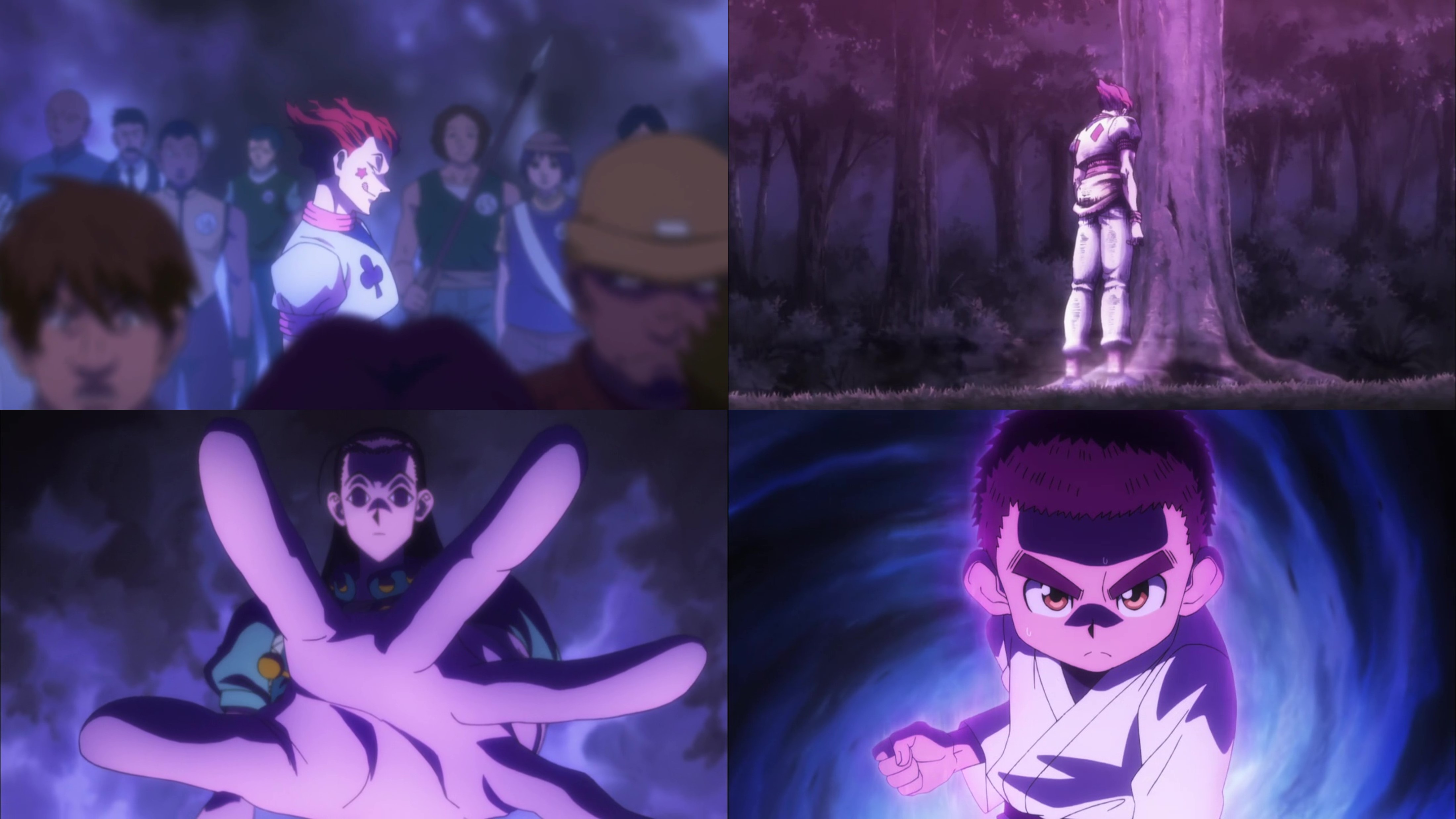 Episodes 7, 20, 27, 28 After stage 2 of the exam, Satotz and Menchi notices Hisoka’s bloodlust and called it an outburst of negative aura giving us direct term to refer to for future displays of bloodlust. The animation team also made it easy to recognise such moments by using a unique visual style. This development culminates into Neferpitou’s vicious aura.
Episodes 7, 20, 27, 28 After stage 2 of the exam, Satotz and Menchi notices Hisoka’s bloodlust and called it an outburst of negative aura giving us direct term to refer to for future displays of bloodlust. The animation team also made it easy to recognise such moments by using a unique visual style. This development culminates into Neferpitou’s vicious aura. 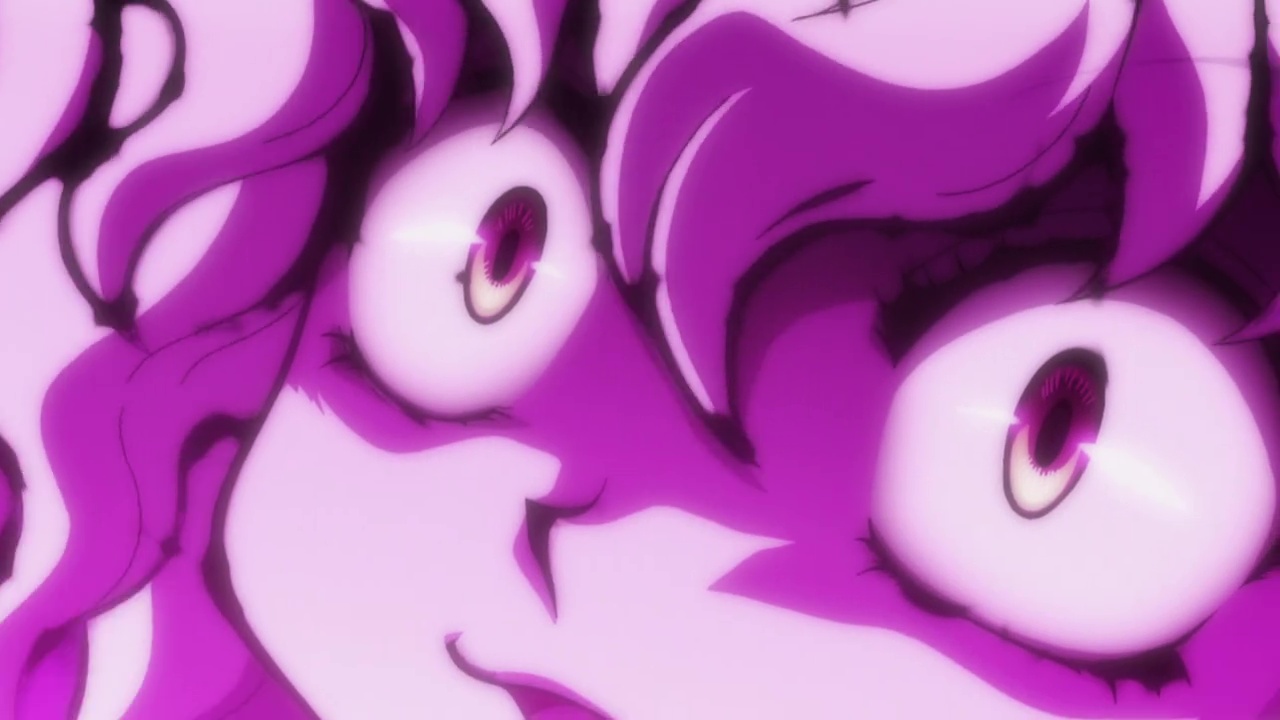 Episode 86
Episode 86
Zebro
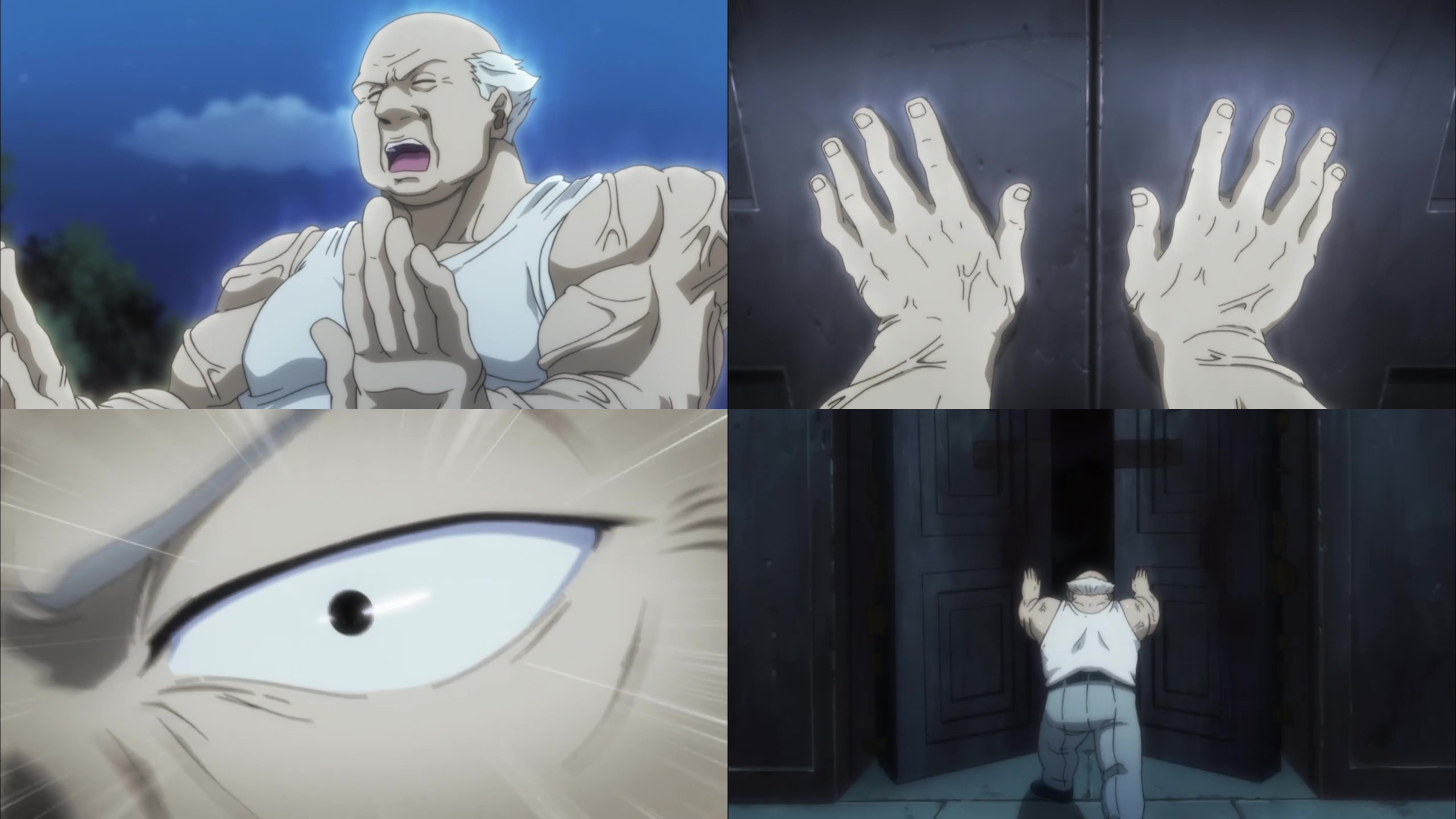 Episode 22 Even the Zoldyck family’s janitor was aware of Nen, as can be seen from the aura around him and a suspiciously similar procedure as shown below.
Episode 22 Even the Zoldyck family’s janitor was aware of Nen, as can be seen from the aura around him and a suspiciously similar procedure as shown below.
As it happens, Master Wing did similar routines to confirm the above cases as valid Nen uses. 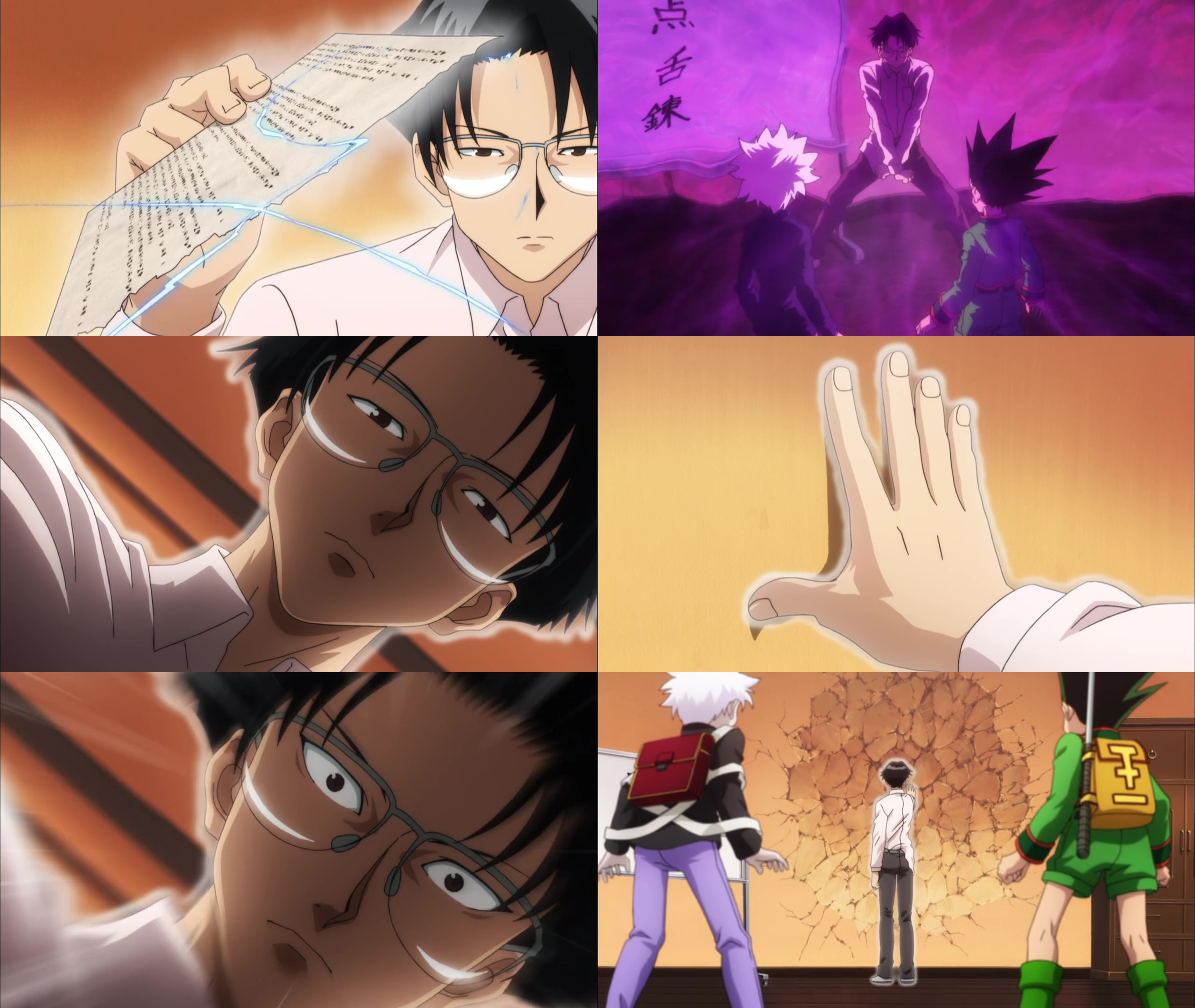 Episode 28
Episode 28
Unintentional × Usage
Cases of unintentional usage of Nen by people
Gon
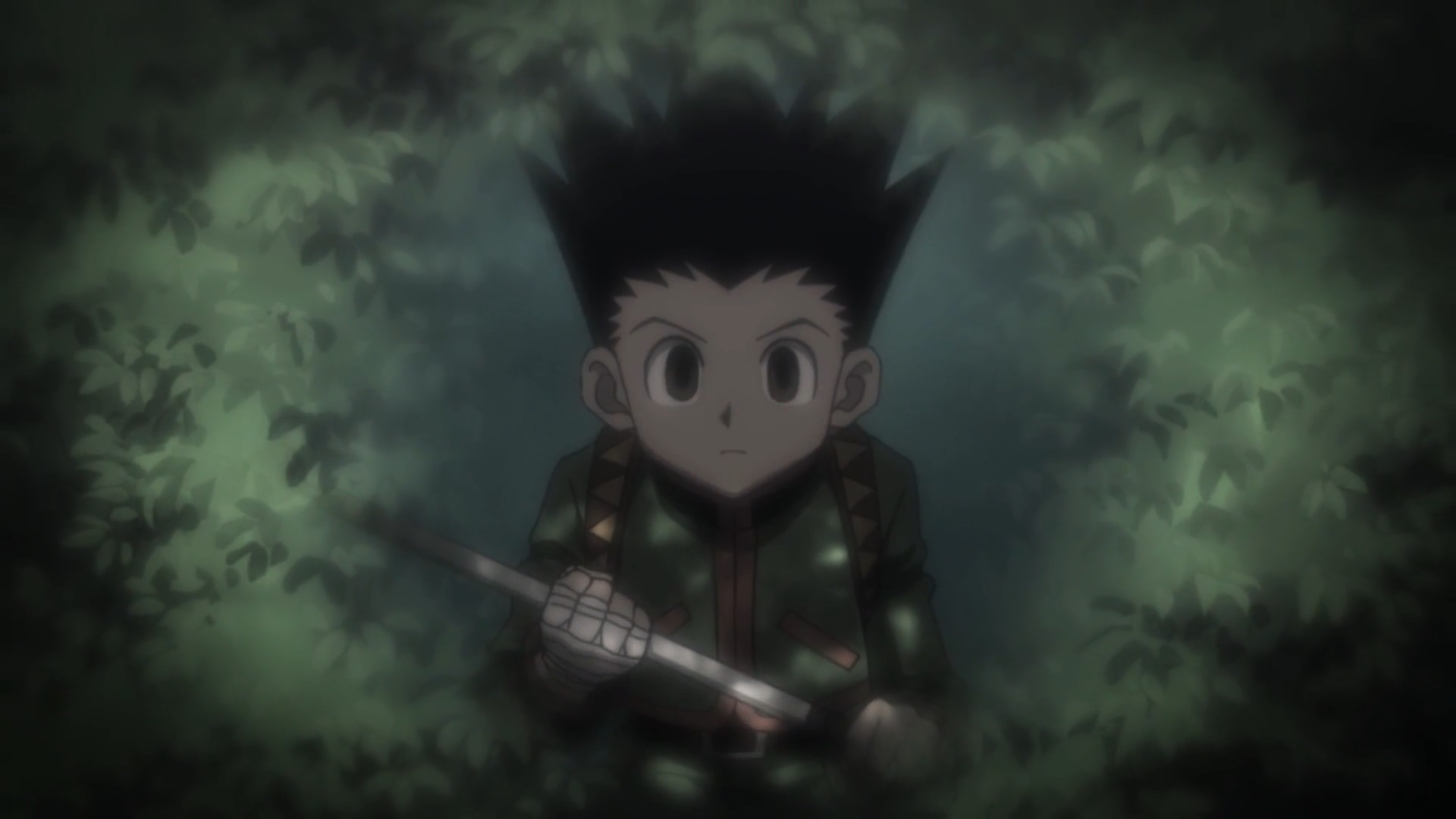 Episode 15 Gon, with his sharp senses, had naturally learned to identify both moments with no presence of life and moments with intense presence of bloodlust. We learned this information while he was observing Pokkle and Hisoka, respectively. While spending his childhood in wildlife, he had already learned the technique to silence his presence called Zetsu, one of the four major Nen principles.
Episode 15 Gon, with his sharp senses, had naturally learned to identify both moments with no presence of life and moments with intense presence of bloodlust. We learned this information while he was observing Pokkle and Hisoka, respectively. While spending his childhood in wildlife, he had already learned the technique to silence his presence called Zetsu, one of the four major Nen principles.
As a bonus, consider the below image where both Nen users are using some vision enhancement ability. The aura around Netero’s fingers (right image) is clearly visible.
Episodes 15, 86 Gon was able to locate the subjects like Hisoka in the left situation. It could be Gon’s senses again which shows that there are people born with natural abilities as well, Nen isn’t everything.
Kurapika
 Episodes 10, 36 After his fight with Majtani, Kurapika described that even when he sees a real spider, his personality changes and he enters into a frenzy. This information, coupled with Hisoka’s personality-based Nen test, reveals that Kurapika’s Nen type changes when his eyes turn red. In fact, the types that fit Kurapika the most are Conjurer (high-strung) and Specialist (individualistic).
Episodes 10, 36 After his fight with Majtani, Kurapika described that even when he sees a real spider, his personality changes and he enters into a frenzy. This information, coupled with Hisoka’s personality-based Nen test, reveals that Kurapika’s Nen type changes when his eyes turn red. In fact, the types that fit Kurapika the most are Conjurer (high-strung) and Specialist (individualistic). 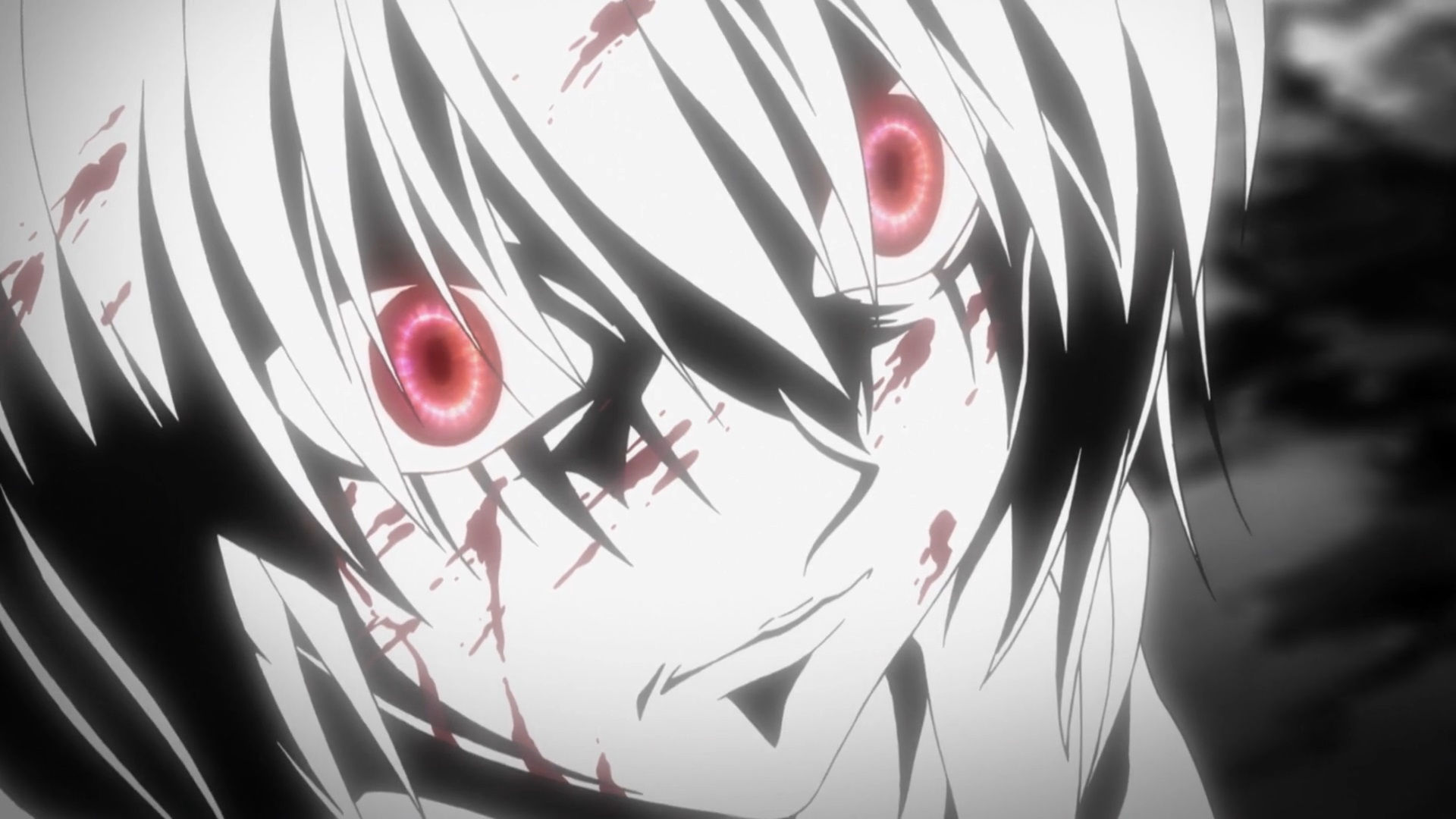 Episode 47
Episode 47
After × Exam
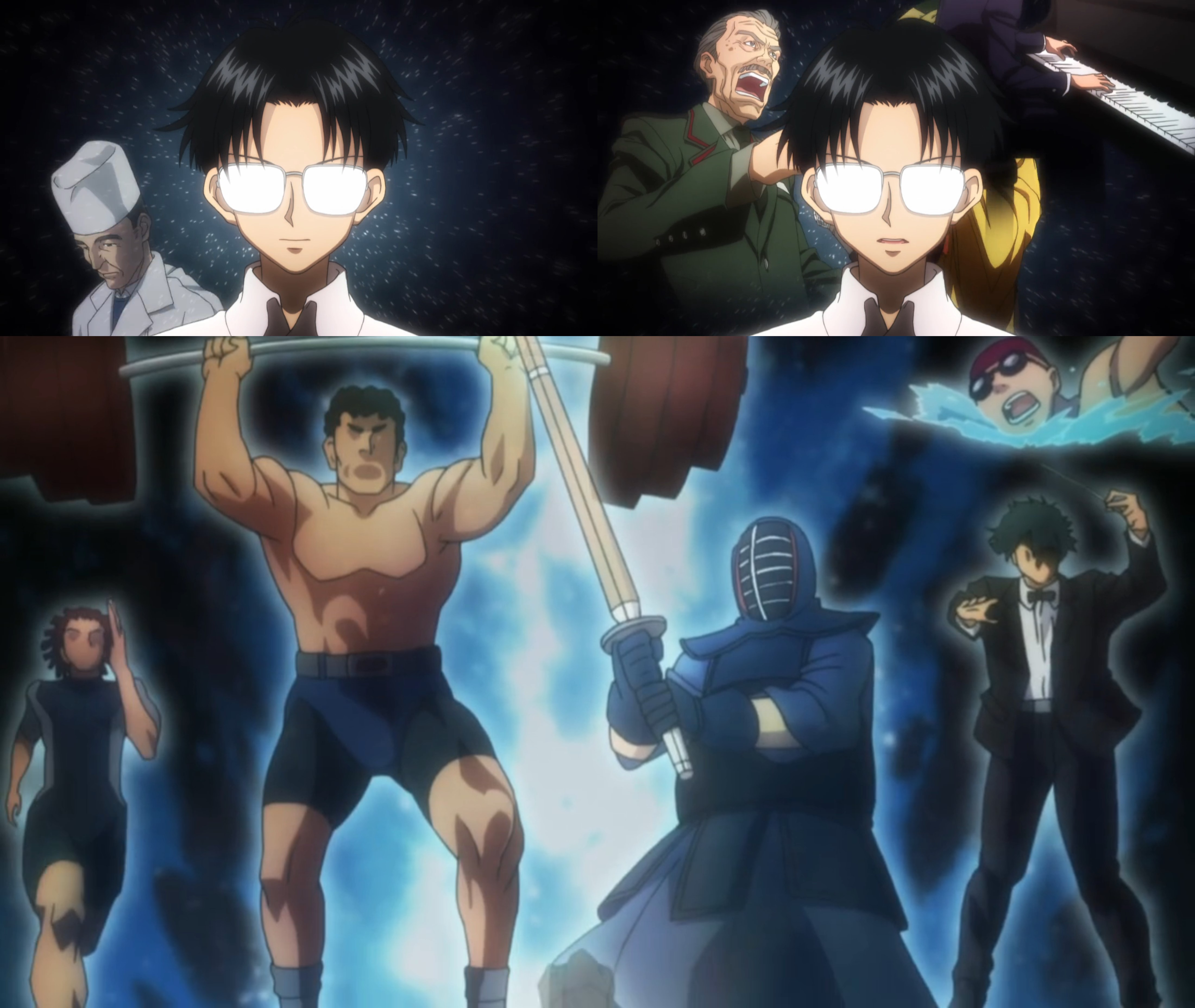 Episodes 29, 33 The unintentional uses don’t stop even after the exam; I mean, why should they stop? :p
Episodes 29, 33 The unintentional uses don’t stop even after the exam; I mean, why should they stop? :p
Continuing our Master Wing’s lesson, we also learnt that only a few people are capable of using Nen; these people are geniuses, leaders, psychics, and superhumans. But, observe that the background includes chefs and pianists, who can be considered as a type of artist. This clearly laid the foundation for future arcs as shown below for Neon, Zepile and Komugi. 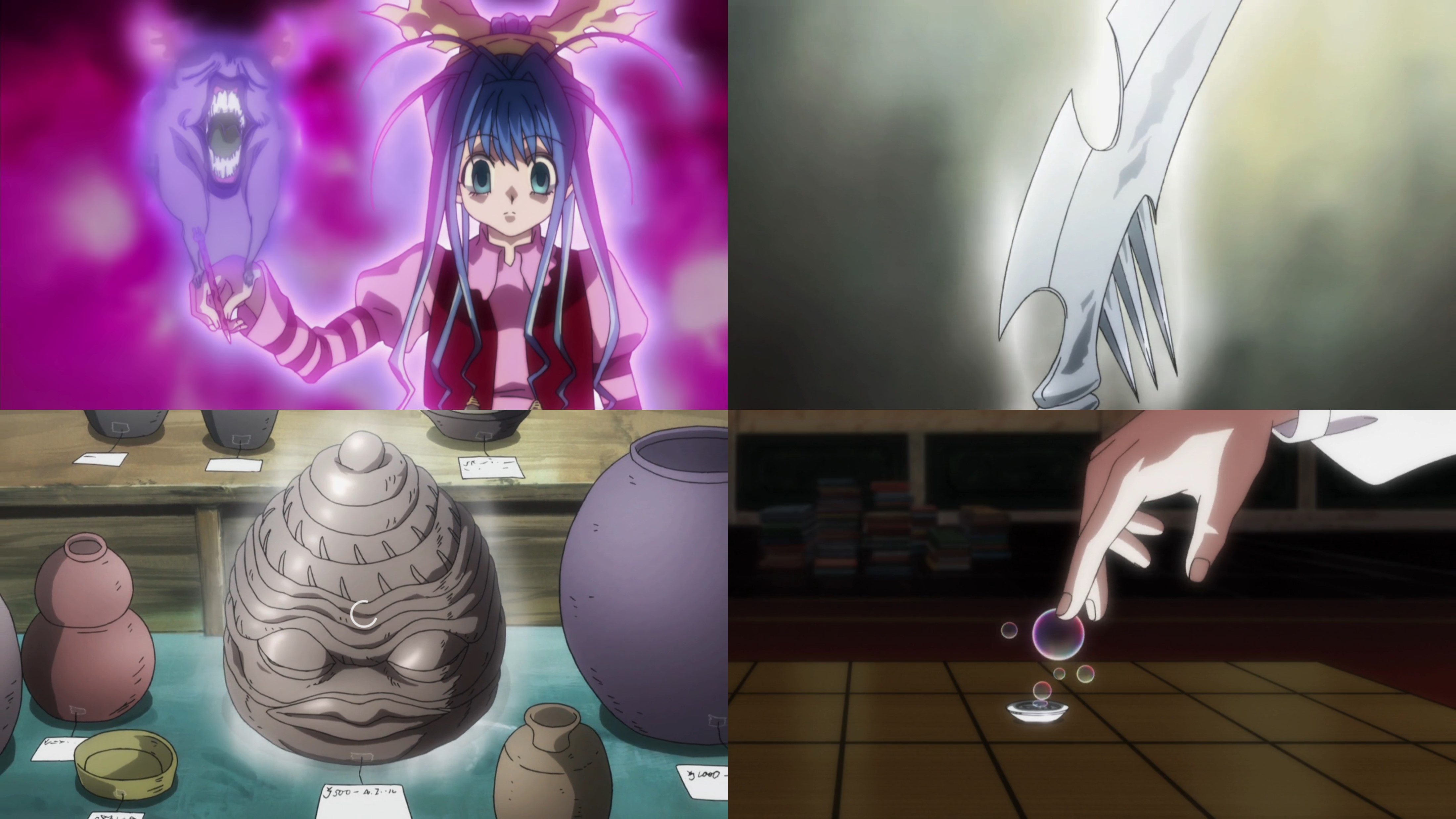 Episodes 41, 48, 108 Here, we also witness the curious case of Ben’s knife, which is later seen during Chrollo’s fight. It also hinted at the possibility of Nen being attached to objects even after the user’s death, nicely setting up plot points for the next arc.
Episodes 41, 48, 108 Here, we also witness the curious case of Ben’s knife, which is later seen during Chrollo’s fight. It also hinted at the possibility of Nen being attached to objects even after the user’s death, nicely setting up plot points for the next arc.  Episode 52
Episode 52
Bisky
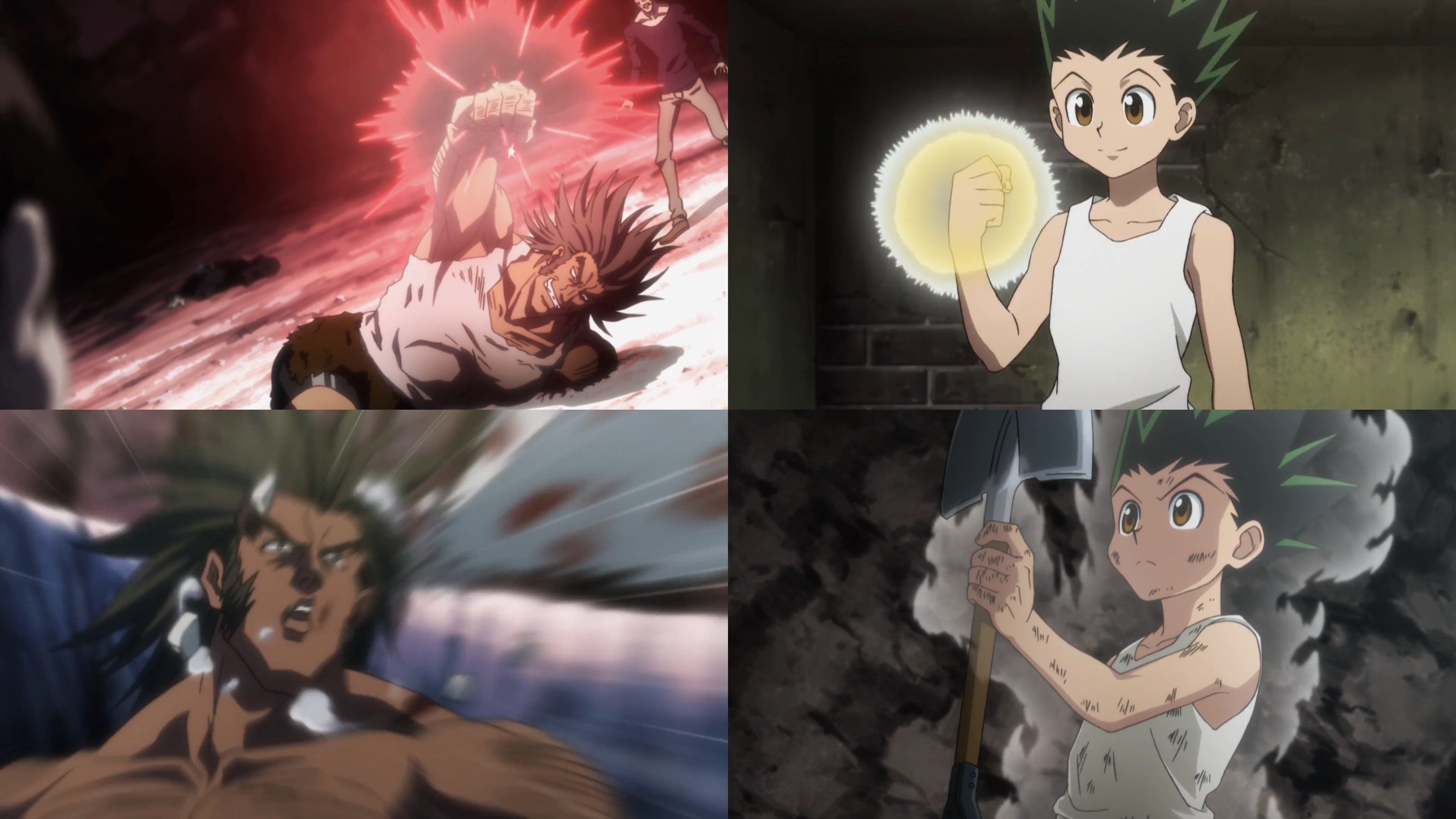 Episodes 44, 59, 63 After Wing, we meet Bisky-chama, and finally learn the names of some advanced techniques previously used by Gon and Uvogin, such as Ko and Shu with their demonstration as shown below.
Episodes 44, 59, 63 After Wing, we meet Bisky-chama, and finally learn the names of some advanced techniques previously used by Gon and Uvogin, such as Ko and Shu with their demonstration as shown below.  Episode 64
Episode 64
Battles
There is a sense of familiarity in the battles of this anime. Apart from usual scale in abilities, a constant theme is a recurring use of skills in fights. Again, let’s start with my favourite example.
Duel × Duels
We are talking about two of the most important fights in the anime: Gon vs Hisoka and Uvogin vs Kurapika and the common strategies used. 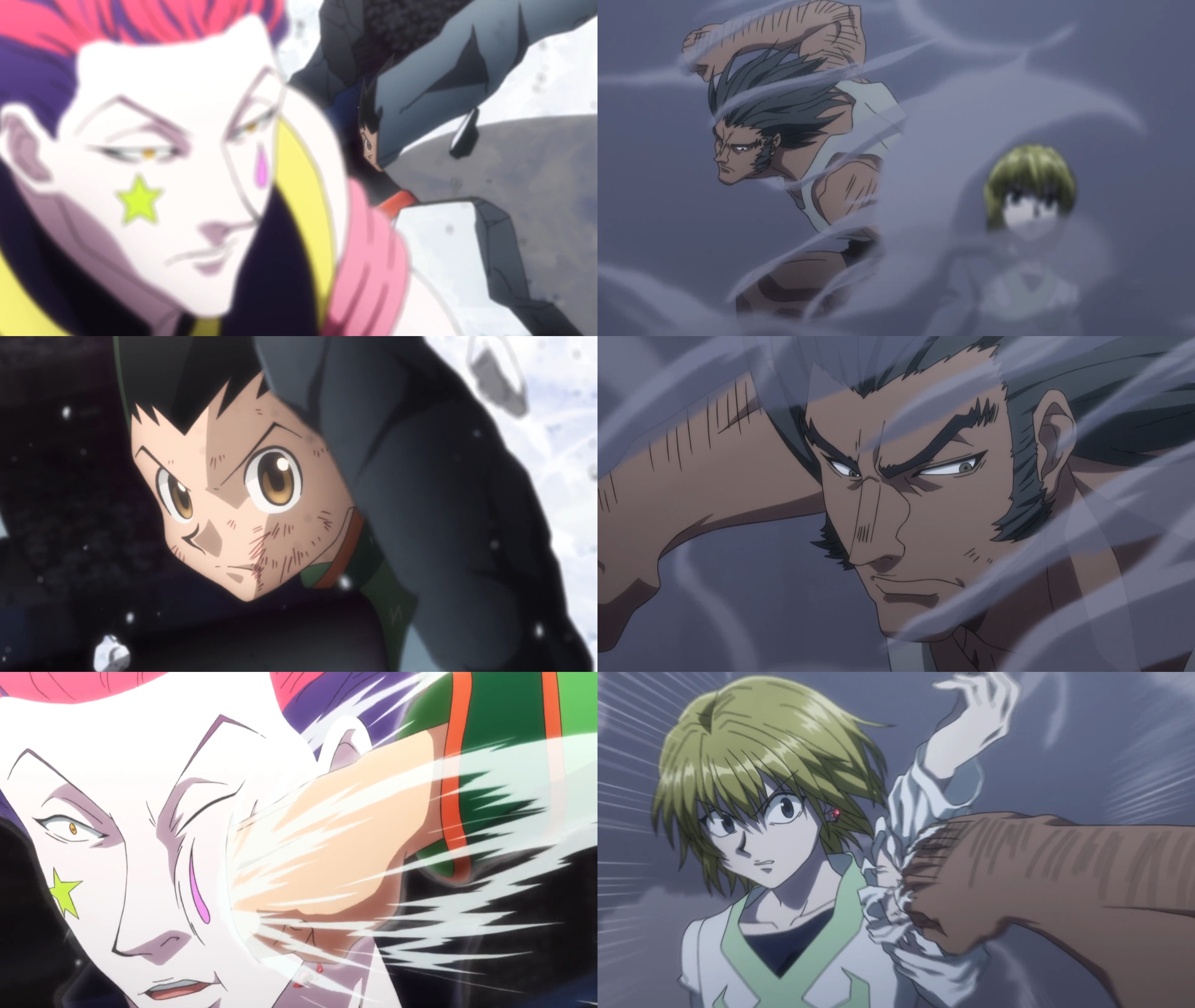 Episodes 35, 47 Gon and Uvo try to distract the opponent and utilise it for a surprise attack by inflicting a powerful punch.
Episodes 35, 47 Gon and Uvo try to distract the opponent and utilise it for a surprise attack by inflicting a powerful punch.  Episodes 36, 47 And both the winners use their ultimate ability, which is concealing with In by distracting their opponents in their own way. Hisoka attached his Bungee Gum while explaining his personality test, while Kurapika’s visible chains deceived Uvogin by making him believe that he was a manipulator.
Episodes 36, 47 And both the winners use their ultimate ability, which is concealing with In by distracting their opponents in their own way. Hisoka attached his Bungee Gum while explaining his personality test, while Kurapika’s visible chains deceived Uvogin by making him believe that he was a manipulator.
Don’t let this distract you from the fact that Bungee Gum has the properties of both rubber and gum.
The characters of Gon and Uvogin (the eventual losers) share so much in common, from their personalities (both are stupid enhancers) to their abilities (like screams, shu and ko), but exploring this will be an overkill for this post. Likewise, the dynamics between the winners is just as interesting.
Now, let’s see character-specific recurring fight techniques.
Gon
Scream
Catch
 Episodes 69, 83 The speed of the rolling armadillo isn’t even close to Razor’s ultra-fast dodgeball throws. And so, Gon made light work of poor Baro.
Episodes 69, 83 The speed of the rolling armadillo isn’t even close to Razor’s ultra-fast dodgeball throws. And so, Gon made light work of poor Baro.
Internal × Clock
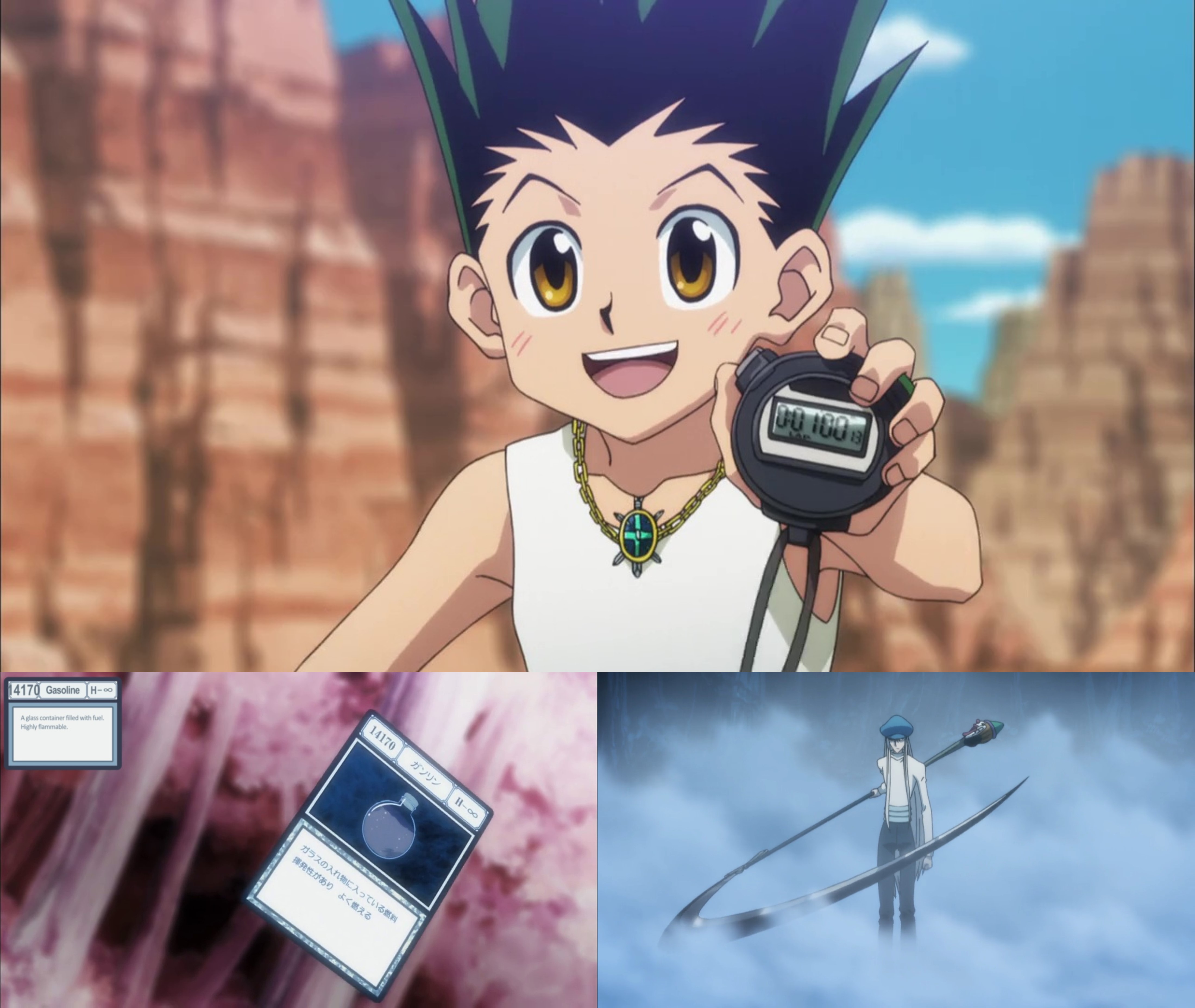 Episodes 73, 83 Gon’s practice to count to exactly one minute helped him in not only knowing when the gasoline card will materialise in his fight against Genthru but also helped him (and Killua) during Kite’s scythe assault, which required him to jump after exactly three seconds.
Episodes 73, 83 Gon’s practice to count to exactly one minute helped him in not only knowing when the gasoline card will materialise in his fight against Genthru but also helped him (and Killua) during Kite’s scythe assault, which required him to jump after exactly three seconds.
Crazy × Hands
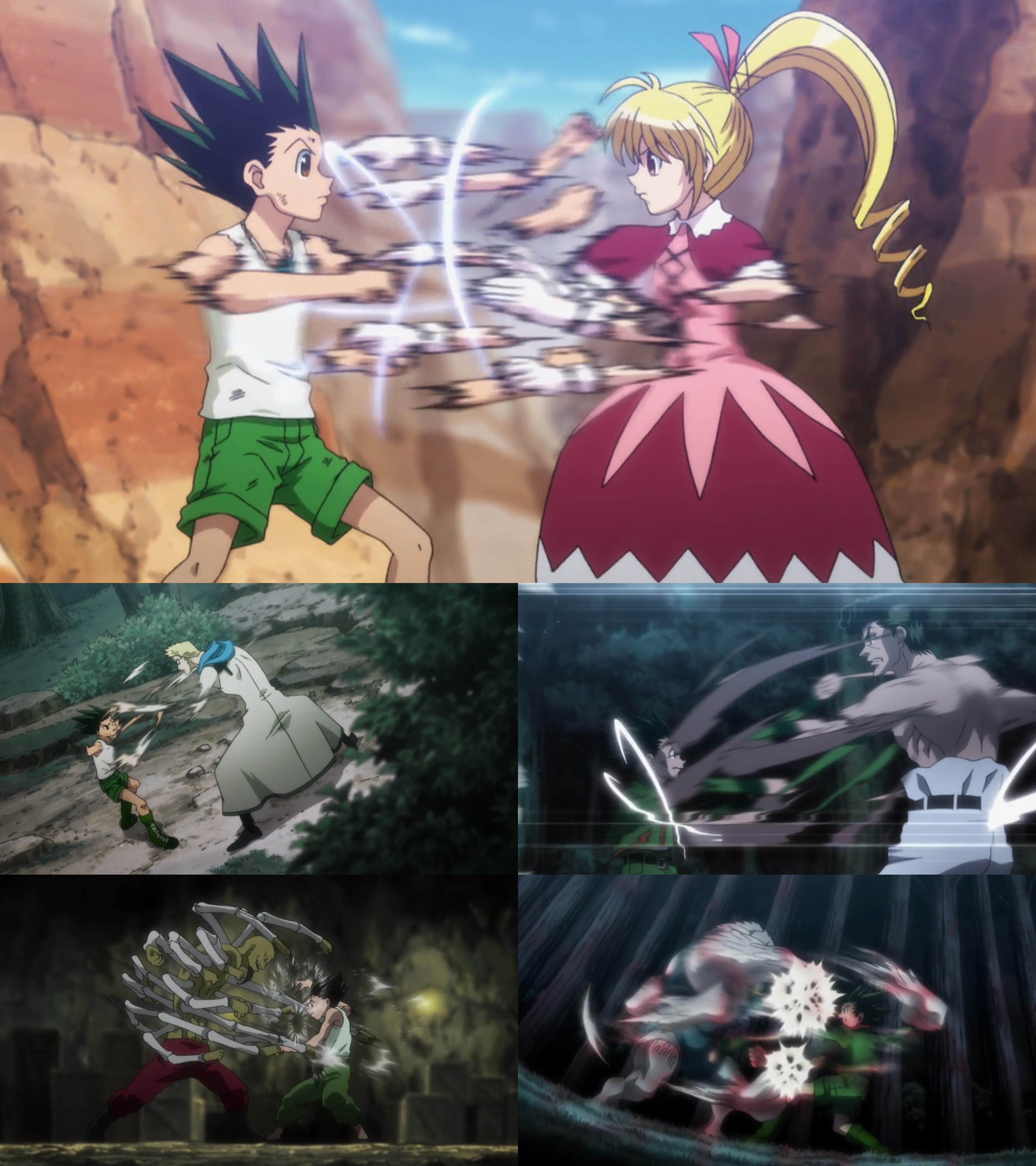 Episodes 72, 74, 82, 90, 99 Another practice session and another useful technique! Fast moving hands turned out to be really important.
Episodes 72, 74, 82, 90, 99 Another practice session and another useful technique! Fast moving hands turned out to be really important.
Killua
Crazy × Hands
Killua gets his fair share of crazy hands too! But, Gon also learned from these.  Episodes 25, 34, 69, 82 Gon is familiar with these hand movements due to Gotoh’s coin games, which meant stopping Riehlvelt’s whips was super easy. He also warned Tsezgerra about the ball’s location which helped him in avoiding a lethal blow. In the last picture, we see how Killua, too uses similar skills to defeat Mosquito.
Episodes 25, 34, 69, 82 Gon is familiar with these hand movements due to Gotoh’s coin games, which meant stopping Riehlvelt’s whips was super easy. He also warned Tsezgerra about the ball’s location which helped him in avoiding a lethal blow. In the last picture, we see how Killua, too uses similar skills to defeat Mosquito.
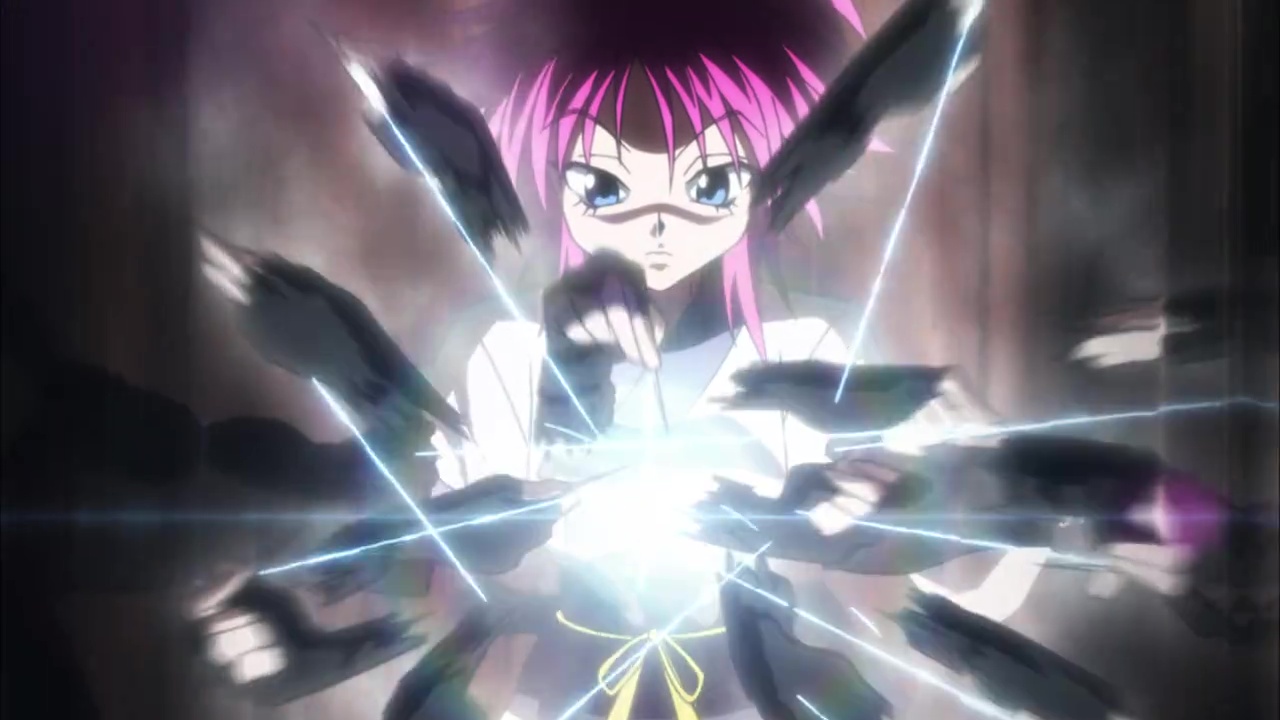 Episode 32 As a viewer, Machi’s insane Nen stitching was another callback to enjoy. But what else?
Episode 32 As a viewer, Machi’s insane Nen stitching was another callback to enjoy. But what else?
Assassin-mode × Kill
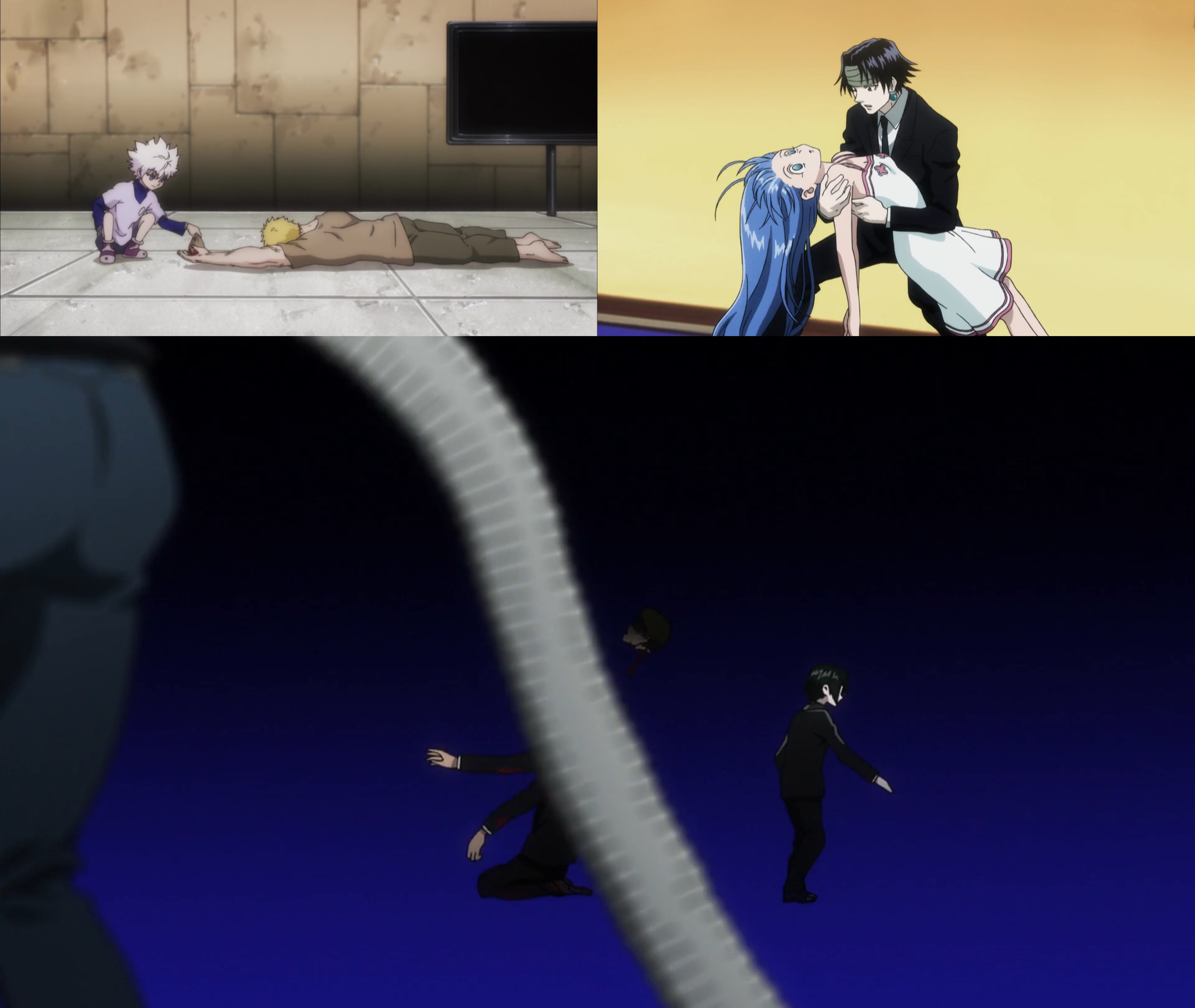 Episodes 11, 43, 51 Killua rips out Johness’s heart without him noticing. But Killua isn’t satisfied due to the presence of blood; he mentions how his old man would have done it without a drop of blood. Then we see Chrollo doing the deed against Neon, but there was a tiny amount of blood. And so this establishes that Chrollo isn’t as powerful as Killua’s old man (Zeno), which ultimately is confirmed by Zeno, but he wasn’t sure if Chrollo was serious about the fight.
Episodes 11, 43, 51 Killua rips out Johness’s heart without him noticing. But Killua isn’t satisfied due to the presence of blood; he mentions how his old man would have done it without a drop of blood. Then we see Chrollo doing the deed against Neon, but there was a tiny amount of blood. And so this establishes that Chrollo isn’t as powerful as Killua’s old man (Zeno), which ultimately is confirmed by Zeno, but he wasn’t sure if Chrollo was serious about the fight.
In between, we also see Feitan performing a similar act, which suggests his Assassin’s Origins.
Ring × of × Fire
 Episodes 50, 68, 129 After being forced into fighting with guys in a ring, he develops a strategy where someone will literally burn if they enter his ring.
Episodes 50, 68, 129 After being forced into fighting with guys in a ring, he develops a strategy where someone will literally burn if they enter his ring.
Abilities
Yes, an obvious scaling is involved, but repetition of ideas increases comfort in understanding the details. And this scaling is often preceded by intense physical exercise and Nen training.
- There is En, where we see its detection range varying from four meters to a couple of kilometres.
- Condition strengthening is also a prominent theme to increase the powers of Nen attacks. It can also be seen as a trade-off to use exceeding skilled abilities. Vows are a stronger case where people with extreme resolve have utilised life-threatening Nen contracts such as Kurapika with his Chain Jail, Kite with his Crazy Slots or Gon :(
In this section, we will focus on some non-basic techniques and their constant usage.
Promise × Thread
 Episodes 30, 37, 104 Master Wing introduced the concept of promise thread with strange designs that breaks using aura. Later, we see its application in breaking the box given by Ging. These designs are even found on Knov’s handcuffs but their purpose isn’t clear.
Episodes 30, 37, 104 Master Wing introduced the concept of promise thread with strange designs that breaks using aura. Later, we see its application in breaking the box given by Ging. These designs are even found on Knov’s handcuffs but their purpose isn’t clear.
Puppets
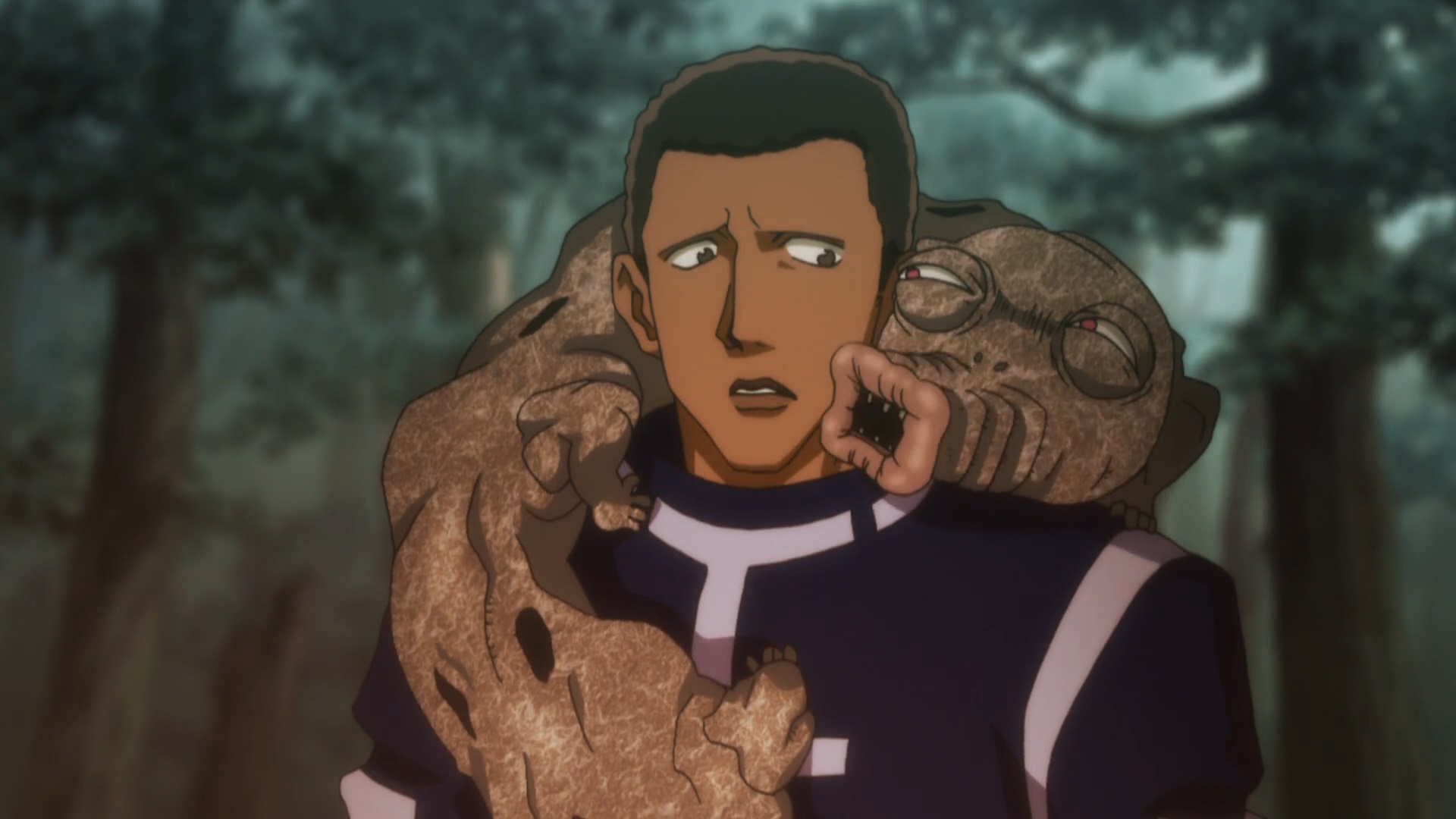 Episode 65 One of the most fascinating abilities in the world of H×H. The technical term for them is Nen Beasts as referenced by Abengane. But of course, we had seen this ability in action before, even if it didn’t have a name back then!
Episode 65 One of the most fascinating abilities in the world of H×H. The technical term for them is Nen Beasts as referenced by Abengane. But of course, we had seen this ability in action before, even if it didn’t have a name back then! 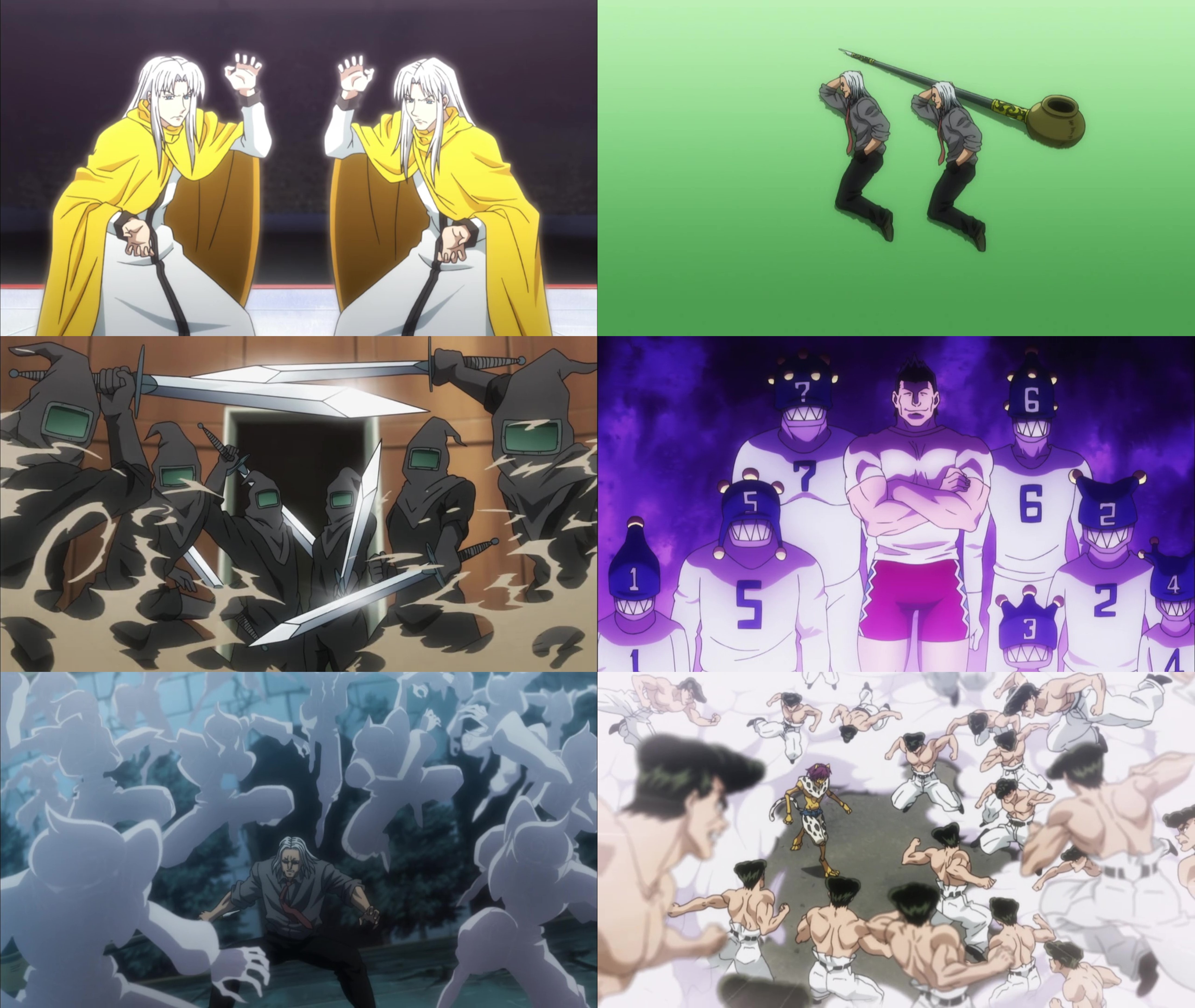 Episodes 32, 40, 69, 95, 104, 120 We were introduced to the concept during the Hisoka vs Kastro fight. From there, we explored puppets of Tocino and Razor. But Morel was the M.V.P., he can not only create a lot of puppets but they are of higher quality than any other puppets seen in the anime. Though quantity-wise, the royal guards are at a completely different level.
Episodes 32, 40, 69, 95, 104, 120 We were introduced to the concept during the Hisoka vs Kastro fight. From there, we explored puppets of Tocino and Razor. But Morel was the M.V.P., he can not only create a lot of puppets but they are of higher quality than any other puppets seen in the anime. Though quantity-wise, the royal guards are at a completely different level.  Episodes 86, 105 Also, an honourable mention for those puppets not intended for direct fights ft. Bisky and Pitou.
Episodes 86, 105 Also, an honourable mention for those puppets not intended for direct fights ft. Bisky and Pitou.
Steal
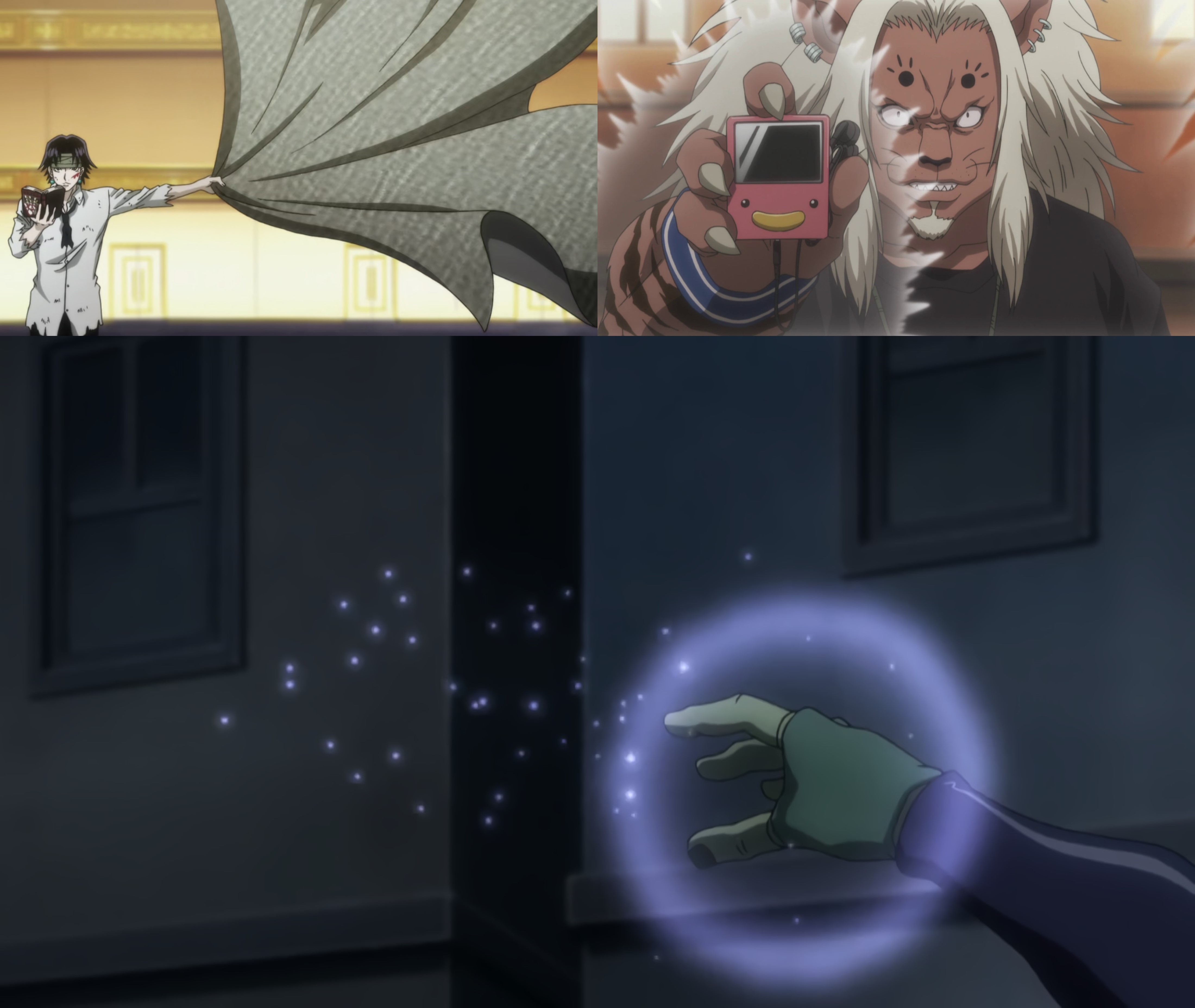 Episodes 52, 106, 135 All the King-like personas share similar Nen abilities. Chrollo, the leader, steals abilities of others using his book; Leol rents the abilities in his Pod, whereas Meruem not only learns the ability of people consumed but also improvises on it to leave us in awe.
Episodes 52, 106, 135 All the King-like personas share similar Nen abilities. Chrollo, the leader, steals abilities of others using his book; Leol rents the abilities in his Pod, whereas Meruem not only learns the ability of people consumed but also improvises on it to leave us in awe.
This, I feel is one of the major evidence for Hisoka’s personality-based Nen test. Thus, we can say that the Nen type and the abilities are not something arbitrary but instead closely linked with the personalities of characters.
 Episodes 90, 123 On the other hand, there is Pouf, whose ability is to bestow Nen abilities to others. There is also Knuckle; he can give his aura for rent, and if the person fails to return it back, then they can’t use Nen for a month. This is achieved using A.P.R., which is a Nen beast. So, this ability combines the above two techniques.
Episodes 90, 123 On the other hand, there is Pouf, whose ability is to bestow Nen abilities to others. There is also Knuckle; he can give his aura for rent, and if the person fails to return it back, then they can’t use Nen for a month. This is achieved using A.P.R., which is a Nen beast. So, this ability combines the above two techniques.
An interesting aspect of H×H’s abilities is that they can be combined in unimaginable ways while effortlessly merging the basics.
 Episodes 51, 115 This Indoor Fish is an ability involving Nen beast which was stolen by Chrollo, while Ikalgo acquired Flutter’s Dragonflies, which ultimately gave way to Pouf’s creative bugs.
Episodes 51, 115 This Indoor Fish is an ability involving Nen beast which was stolen by Chrollo, while Ikalgo acquired Flutter’s Dragonflies, which ultimately gave way to Pouf’s creative bugs. 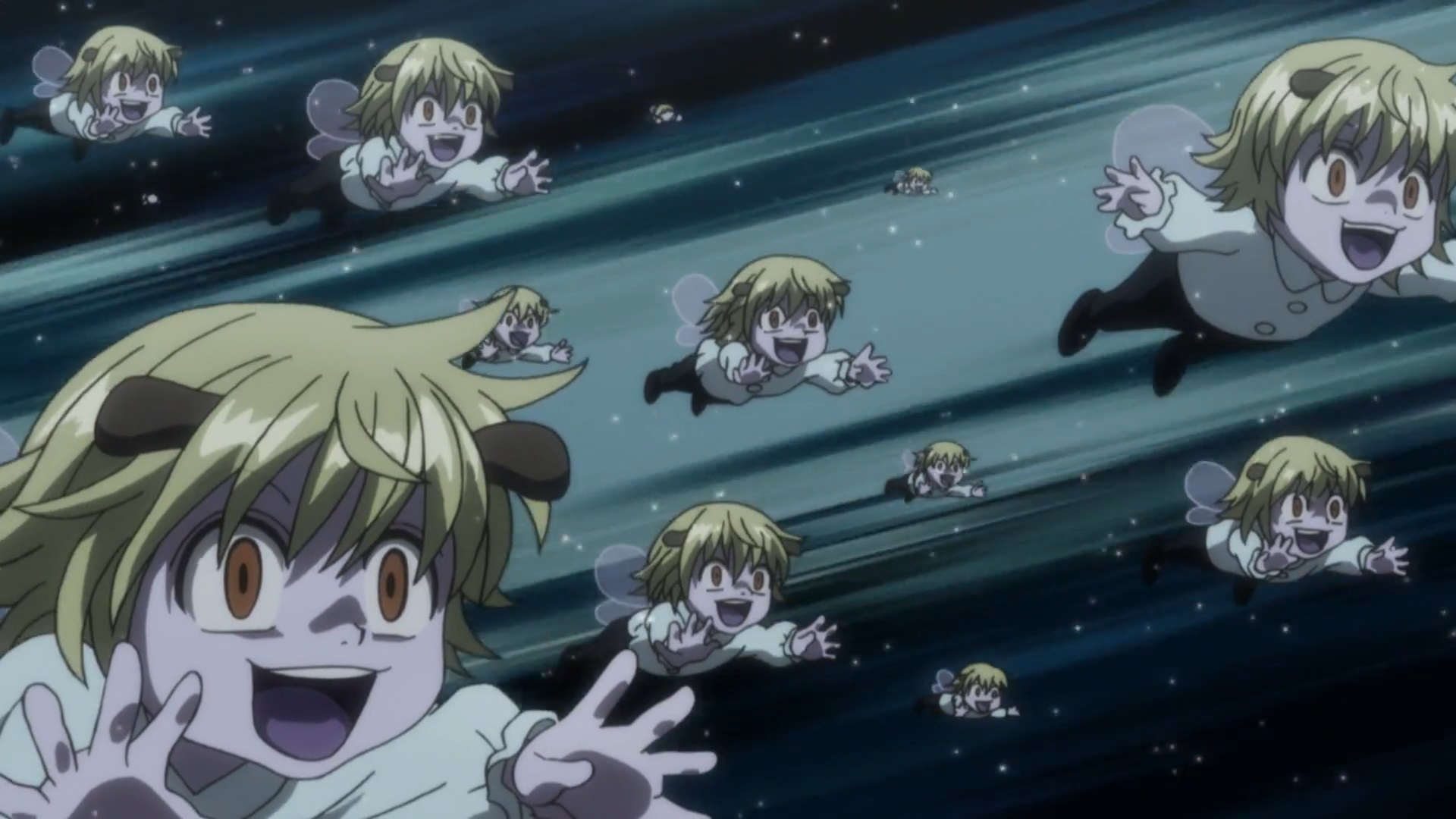 Episode 125
Episode 125
Behavioural × and × Physique × Analysis
 Episode 38 Speaking of Pouf’s abilities, remember the conversation between Gon and Killua after the tape self-erased when they stopped hearing Ging’s message. Killua said, “Using data you can determine the speaker’s height, weight, gender, age, facial features, chronic diseases, and state of mind. I wouldn’t be surprised if there were a Nen user somewhere who could analyse data better than a machine. Someone who would know everything about a person just from hearing their voice.”
Episode 38 Speaking of Pouf’s abilities, remember the conversation between Gon and Killua after the tape self-erased when they stopped hearing Ging’s message. Killua said, “Using data you can determine the speaker’s height, weight, gender, age, facial features, chronic diseases, and state of mind. I wouldn’t be surprised if there were a Nen user somewhere who could analyse data better than a machine. Someone who would know everything about a person just from hearing their voice.” 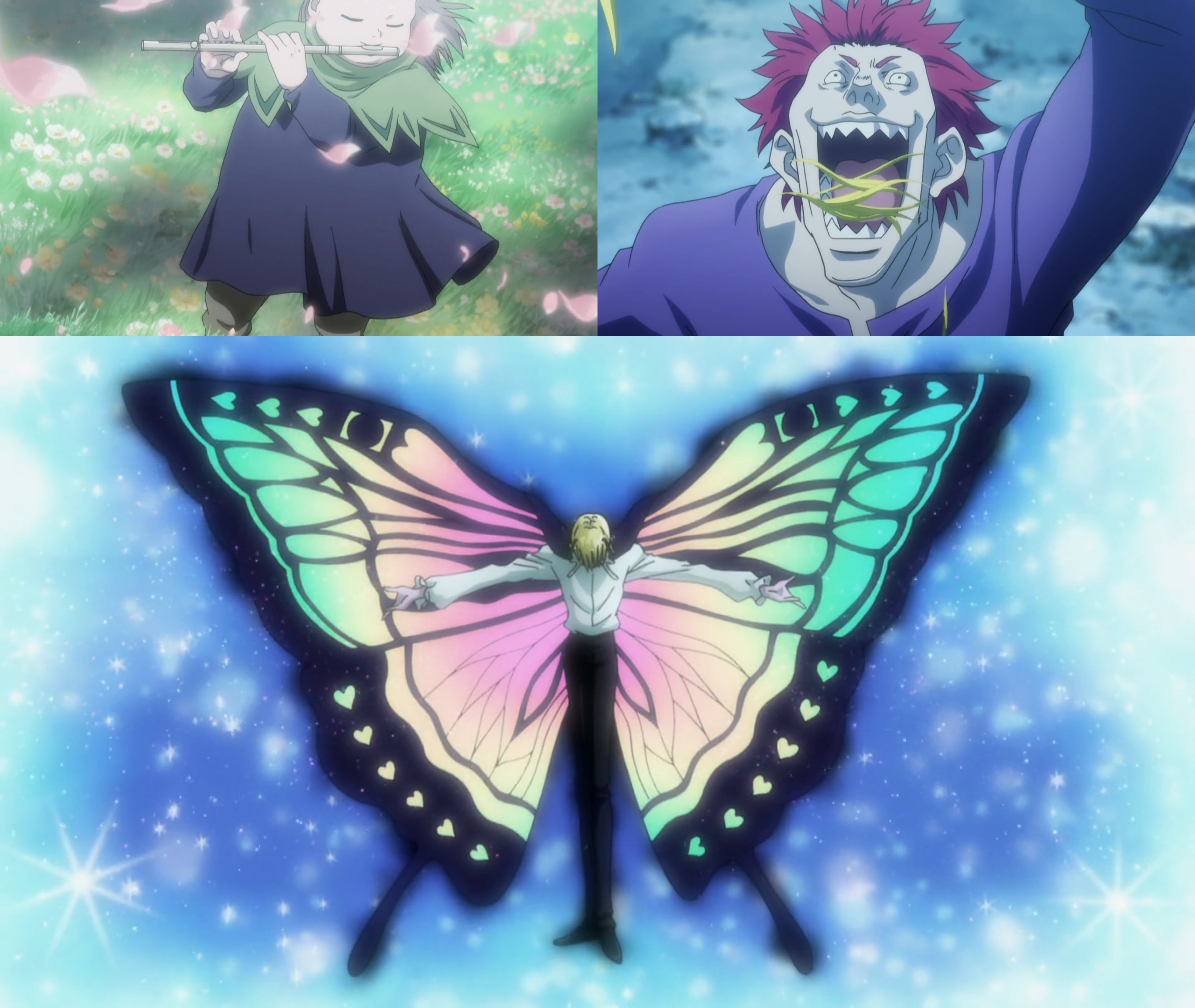 Episodes 44, 63, 113 We then met Melody with extraordinary hearing capabilities that can also influence the listener by playing various songs and Binolt, who can learn physique-related information such as age, and potential for disease by eating hairs of the opponent. These give rise to Pouf’s ability, ‘Spiritual Message’, which enables him to determine the psychological state of the opponent and induce a hypnotic effect by bringing his scales into contact with them.
Episodes 44, 63, 113 We then met Melody with extraordinary hearing capabilities that can also influence the listener by playing various songs and Binolt, who can learn physique-related information such as age, and potential for disease by eating hairs of the opponent. These give rise to Pouf’s ability, ‘Spiritual Message’, which enables him to determine the psychological state of the opponent and induce a hypnotic effect by bringing his scales into contact with them.
Storage
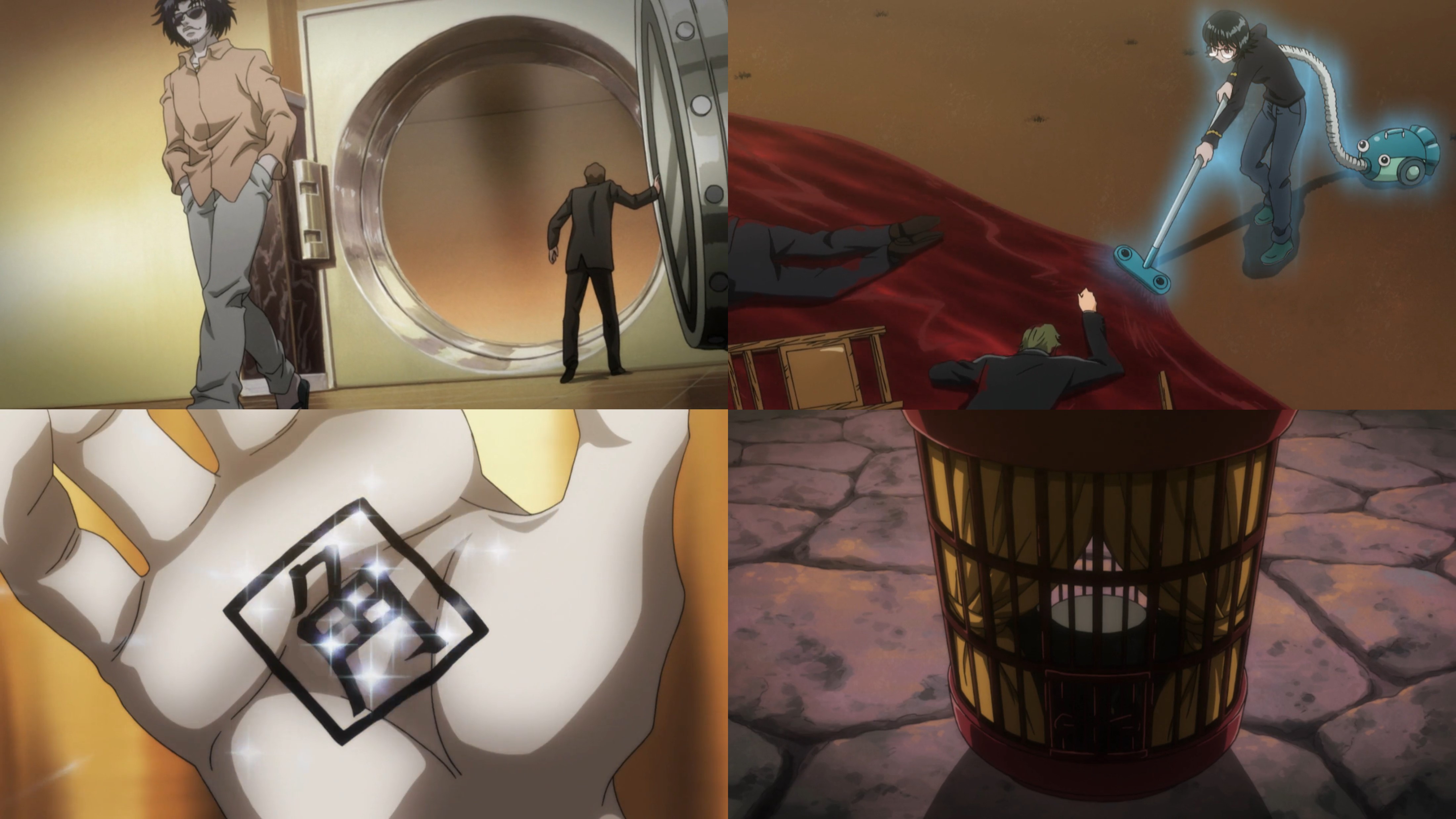 Episodes 43, 86, 95 Owl had a cloth to shrink items. Shizuku’s vacuum cleaner sucks any non-living objects, though only the last item can be regurgitated. Then there is Shoot who can turn small objects into imprints or can potentially seal off their target’s entire body.
Episodes 43, 86, 95 Owl had a cloth to shrink items. Shizuku’s vacuum cleaner sucks any non-living objects, though only the last item can be regurgitated. Then there is Shoot who can turn small objects into imprints or can potentially seal off their target’s entire body.  Episodes 103, 104 Meanwhile, Shoot’s master, Knov is chilling in another Nen dimension with his four-floor building with 21 rooms while Cheetu is anything but chill when he has nothing to do in his Nen dimension.
Episodes 103, 104 Meanwhile, Shoot’s master, Knov is chilling in another Nen dimension with his four-floor building with 21 rooms while Cheetu is anything but chill when he has nothing to do in his Nen dimension.
Ideas
This part mostly deals with examples that rely on implanting ideas upon viewers that are not necessarily about the technicalities of fighting.
An example would be to call out the one-sided nature of most major fights in H×H. Even then, it is not easy to figure out the winner, as Nen fights are not just about sheer strength. Think about it!
It also includes the usage of some brilliant shots that convey similar themes throughout the show.
Ging’s × Fishing Rod
 Episodes 1, 34, 37 That fishing rod is unrealistically strong, but as the portrait suggests, Ging might have played a role in this.
Episodes 1, 34, 37 That fishing rod is unrealistically strong, but as the portrait suggests, Ging might have played a role in this.
Netero’s × Weakness
 Episodes 7, 122 In the Showdown × On × The airship episode, Netero challenges Gon and Killua for a small game to snatch the ball away from him, where they will be rewarded with hunter licenses if they pass. This episode has striking similarities with Netero’s fight against Meruem hundred episodes later, where the reward for Meruem is his name bestowed by this mother.
Episodes 7, 122 In the Showdown × On × The airship episode, Netero challenges Gon and Killua for a small game to snatch the ball away from him, where they will be rewarded with hunter licenses if they pass. This episode has striking similarities with Netero’s fight against Meruem hundred episodes later, where the reward for Meruem is his name bestowed by this mother.
In the earlier episode, Netero avoided using his right hand and left leg, suggesting his possible preference towards them. Later, Meruem recognised this bias for his arms and exploited it by taking out his weaker left hand and right leg.
Hisoka’s × Card Tower
 Episodes 7, 36 This episode also had a mundane moment with Hisoka patiently building a tower (> insert waiting for Gon to ripen); the height of which skyrockets during his fight with Gon at Heavens Arena, signifying Gon’s immense growth.
Episodes 7, 36 This episode also had a mundane moment with Hisoka patiently building a tower (> insert waiting for Gon to ripen); the height of which skyrockets during his fight with Gon at Heavens Arena, signifying Gon’s immense growth.
Unexpected × Teammates
 Episodes 8, 71 From the card tower to another tower full of tricks. Teaming up with the villains is so cool, I wished more anime did this.
Episodes 8, 71 From the card tower to another tower full of tricks. Teaming up with the villains is so cool, I wished more anime did this.
Gon’s × Agony
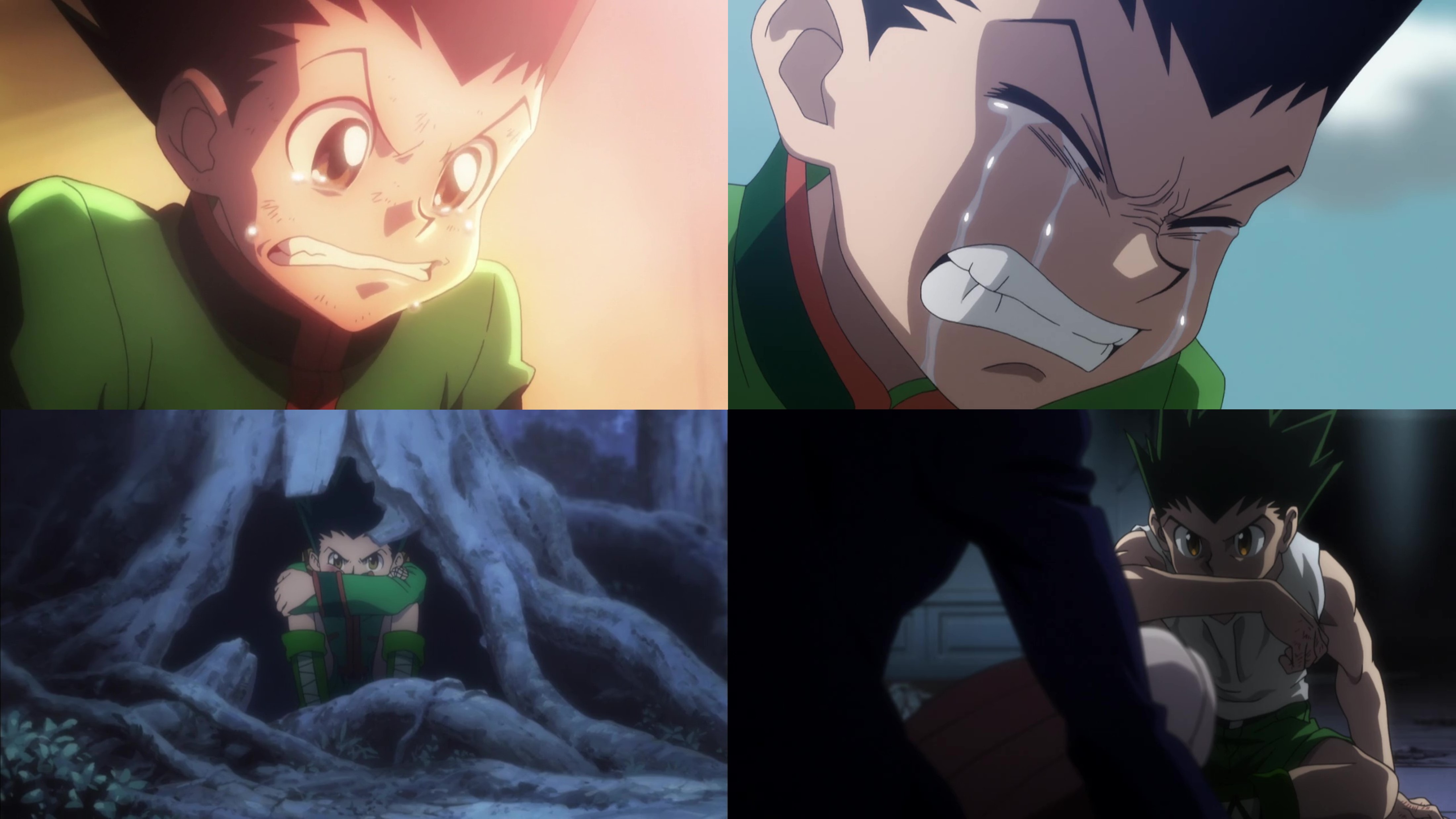 Episodes 16, 18, 91, 116 We see the brutal display of Gon’s emotions when he had to owe one to Hisoka or when he lost to Knuckle due to him being weak. He also had a similar stance to denote the feeling of anguish against Hisoka and Pitou. In the first case, Hisoka refused to accept take back his badge and in the second case, Pitou refused to fight Gon due to the Komugi situation.
Episodes 16, 18, 91, 116 We see the brutal display of Gon’s emotions when he had to owe one to Hisoka or when he lost to Knuckle due to him being weak. He also had a similar stance to denote the feeling of anguish against Hisoka and Pitou. In the first case, Hisoka refused to accept take back his badge and in the second case, Pitou refused to fight Gon due to the Komugi situation.
Disguise
 Episodes 22, 148 Kiriko’s disguise was in action in the second episode and also in the last episode. And guess what, Kiriko replaces Gotoh, a butler of the Zoldyck family who stressed the importance of safety against threats involving disguise, to Gon.
Episodes 22, 148 Kiriko’s disguise was in action in the second episode and also in the last episode. And guess what, Kiriko replaces Gotoh, a butler of the Zoldyck family who stressed the importance of safety against threats involving disguise, to Gon.  Episodes 20, 58 And, we see that Illumi, another Zoldyck, is quite skilful in changing his appearances to Gittarackur and Hisoka.
Episodes 20, 58 And, we see that Illumi, another Zoldyck, is quite skilful in changing his appearances to Gittarackur and Hisoka.
Self-Destruction × Prevention
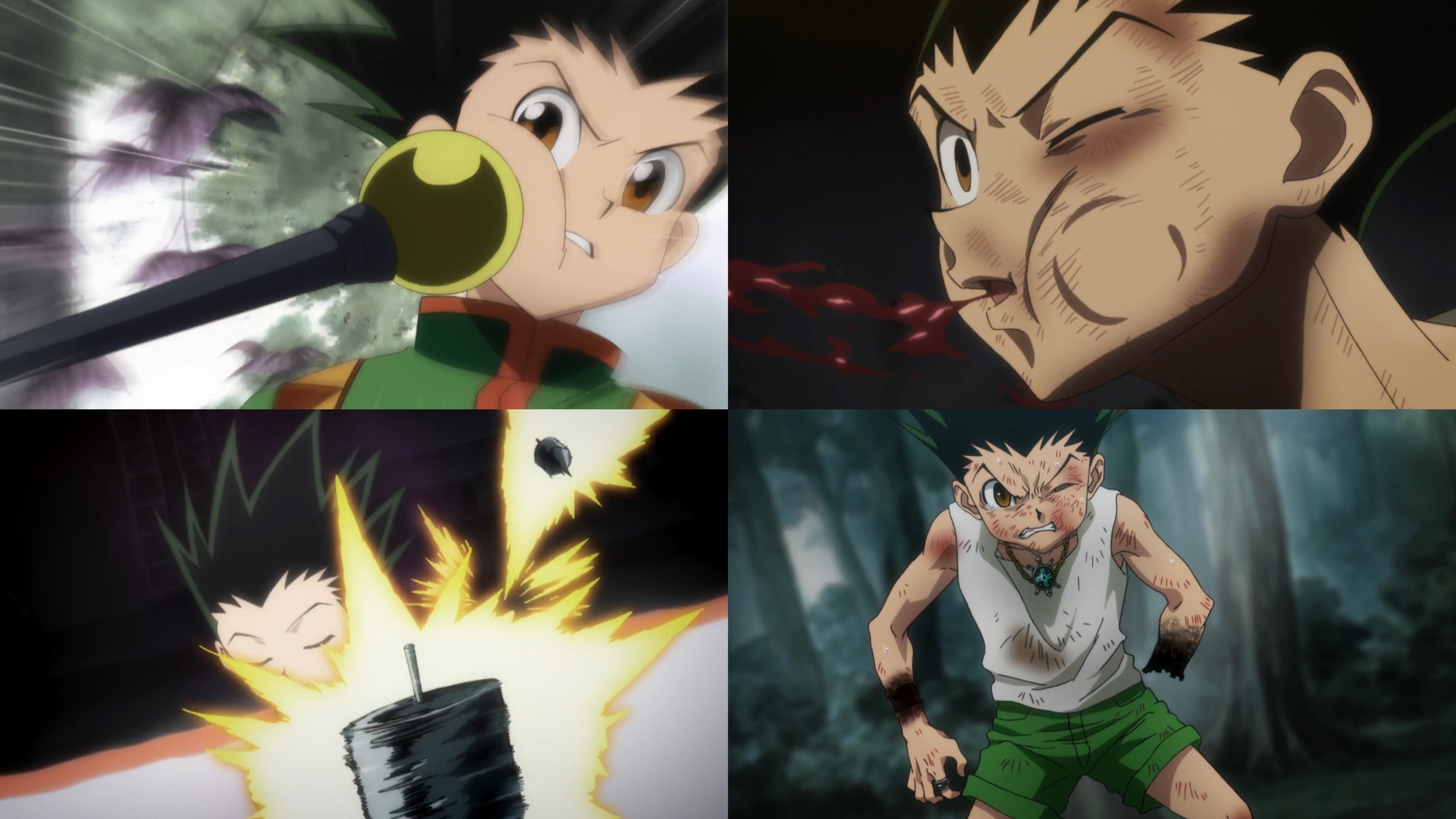 Episodes 23, 30, 74, 95 While Killua was mostly self-aware to avoid fighting with stronger opponents (thanks to Illumi), Gon wasn’t, as we saw in his careless fights against Gido and Genthru, or the way he let Canary and Kite brutally beat him.
Episodes 23, 30, 74, 95 While Killua was mostly self-aware to avoid fighting with stronger opponents (thanks to Illumi), Gon wasn’t, as we saw in his careless fights against Gido and Genthru, or the way he let Canary and Kite brutally beat him.  Episodes 50, 85 So, Killua prevented Gon’s self-destruction during their first meeting with Pitou in a similar way to Gon beating him when they were trapped with Nobunaga.
Episodes 50, 85 So, Killua prevented Gon’s self-destruction during their first meeting with Pitou in a similar way to Gon beating him when they were trapped with Nobunaga.
Walking × Between × Opponents
 Episodes 34, 112 While everyone remembers the badass Meruem’s walk, Killua did it first against the Heavens Arena contestants :)
Episodes 34, 112 While everyone remembers the badass Meruem’s walk, Killua did it first against the Heavens Arena contestants :)
Gungi × Palace Invasion
 Episodes 105, 128 Gungi can in fact, explain the entire chimera ant arc.2 But let’s focus on the main theme of Kokoriko which represents Humanity. It was a move developed by Komugi, which quickly became popular and one day was used against Komugi. So, she created a countermeasure to it and, in a way, killed her own development. But, later, she again used Kokoriko against Meruem stating that she has developed a counter to a counter.
Episodes 105, 128 Gungi can in fact, explain the entire chimera ant arc.2 But let’s focus on the main theme of Kokoriko which represents Humanity. It was a move developed by Komugi, which quickly became popular and one day was used against Komugi. So, she created a countermeasure to it and, in a way, killed her own development. But, later, she again used Kokoriko against Meruem stating that she has developed a counter to a counter.
Similarly, Meruem was initially trapped by the Poor Man’s Rose. But he was revived by his guards and became stronger than ever. But, the Rose contained poison, dealing a final blow to the King and victory to humans.
Throughout the series, we see Meruem stating “Do not make me repeat myself” to various characters such as Peggy, Turtle, Shaiapouf, Menthuthuyoupi, the national shogi champion and even the chairman Netero wasn’t given respect. And then, he actually proceeds to not repeat his words in front of them. But these were his words spoken to Palm for Komugi, “You need further explanation? It seems you doubt what you’ve just heard. I shall repeat myself.”
Episode 135
Conclusion
Hopefully, I delivered my point. There’s a lot more to say about this series, from the story dynamics and the character development, to the foreshadowing3 and the themes4 of the show. But I believe there are people who are better at this job.
Anyway, what am I saying, we’ve just gotten started!5 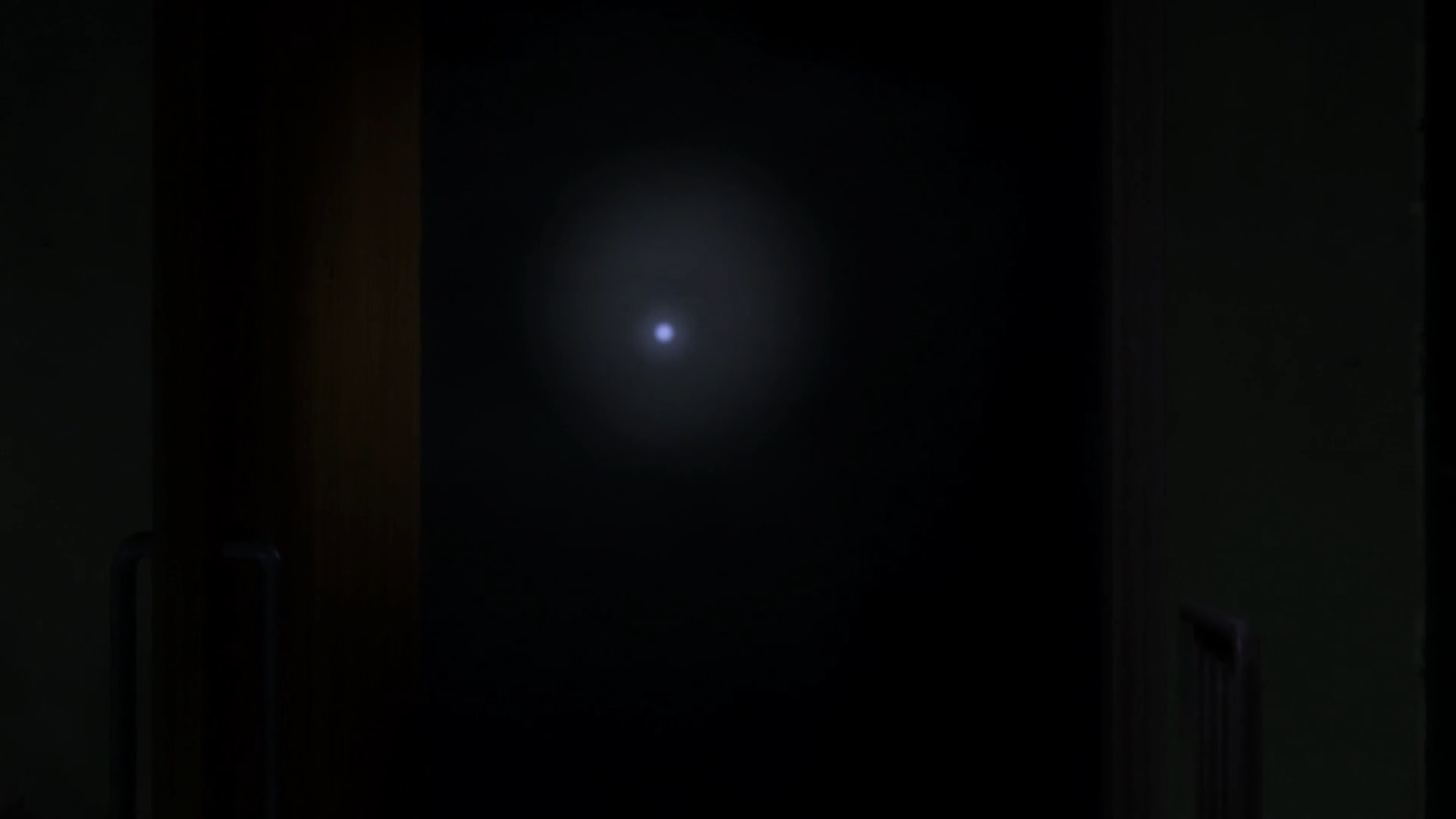
External Links
Entire Chimera Ant Arc Explained through Gungi by Dougurasufilm ↩︎
Hunter × Hunter reaction playlist by FILMBuFF, rewatching the series with his reactions inspired me to make this post. ↩︎
Hunter × Hunter analysis playlist by Aleczandxr, this guy was the reason (at least partly) I gave this 100+ episode series a shot. ↩︎
Exactly, there’s a lot more to say and I will keep updating this post :) ↩︎

